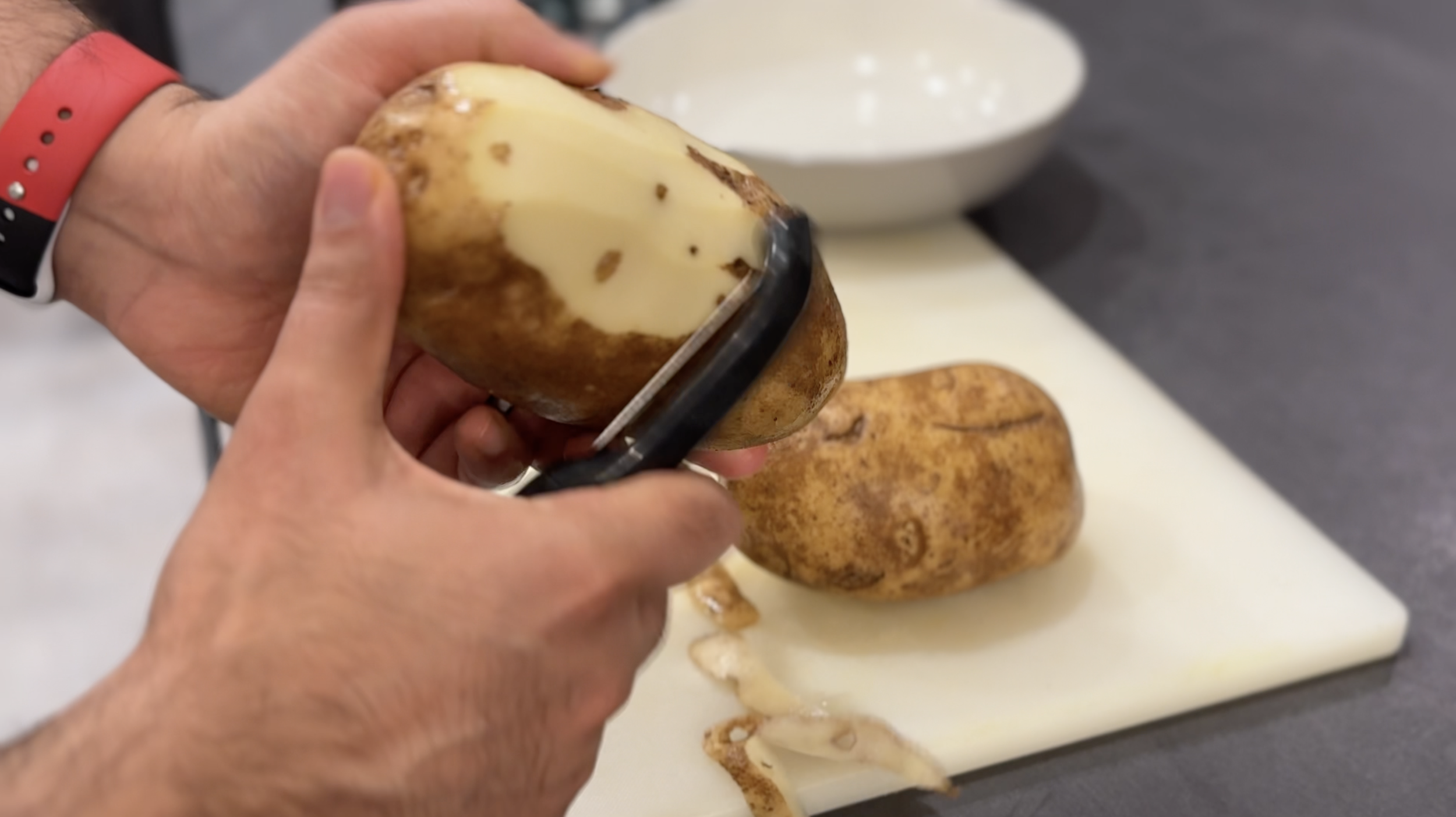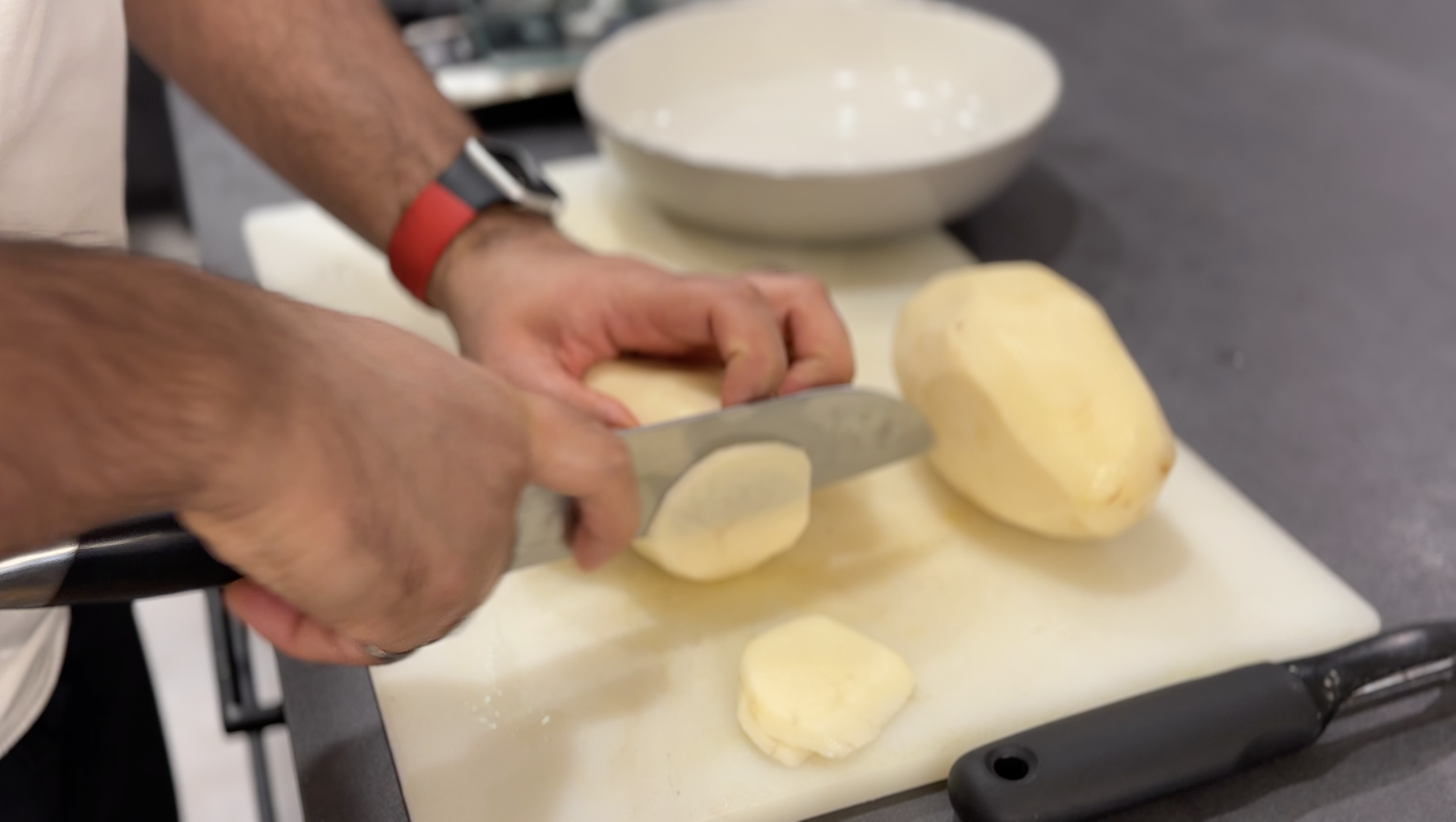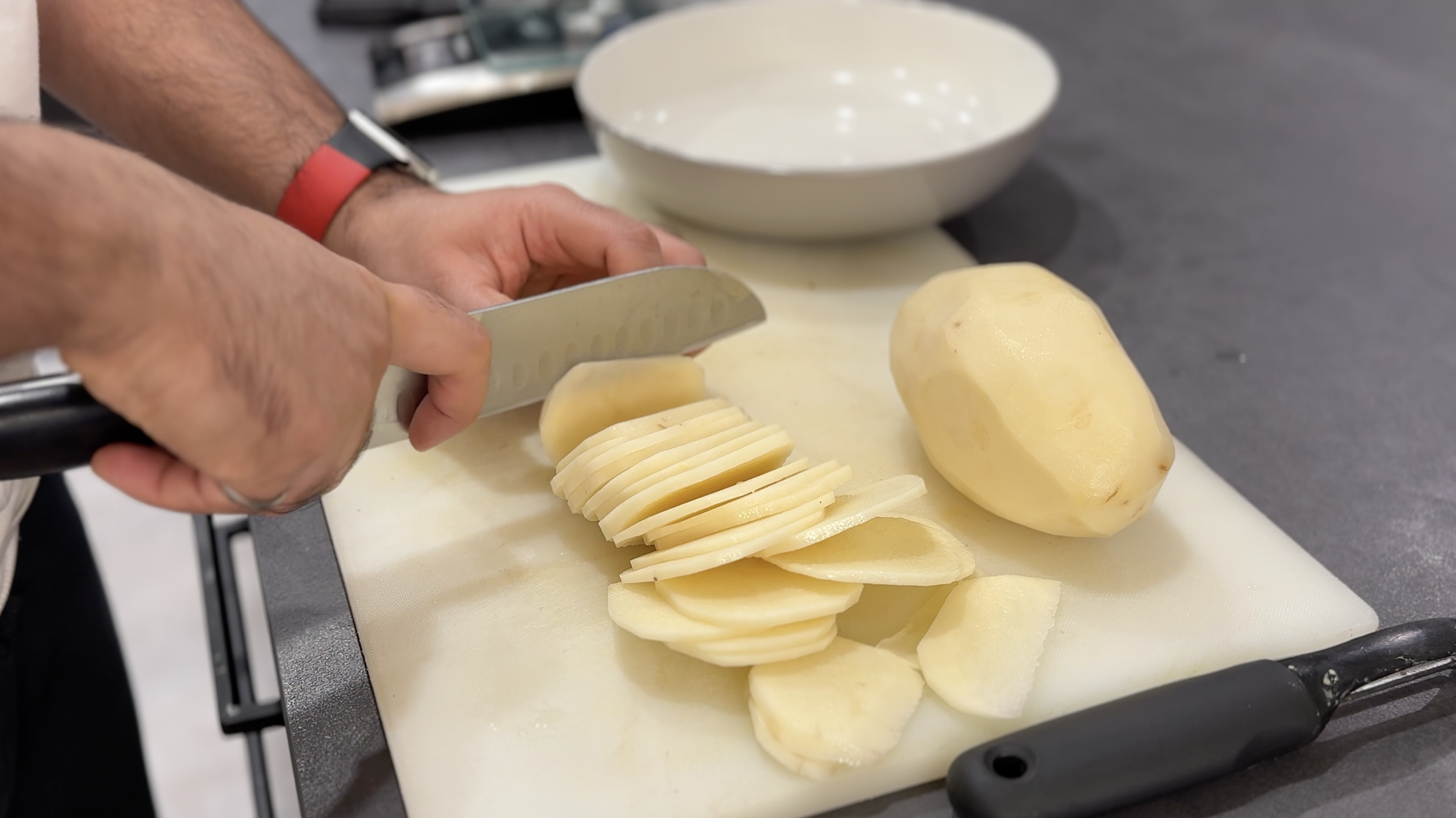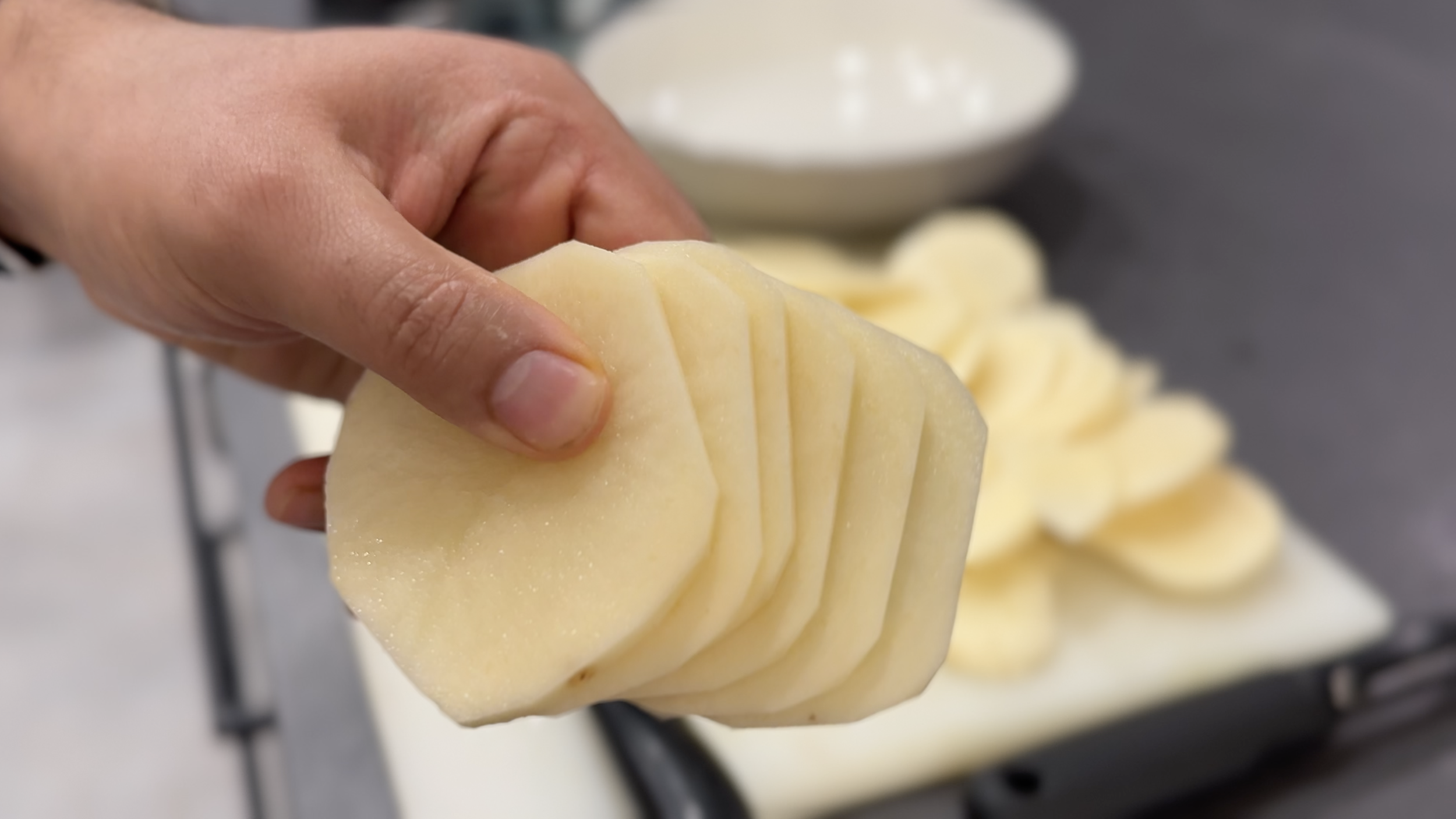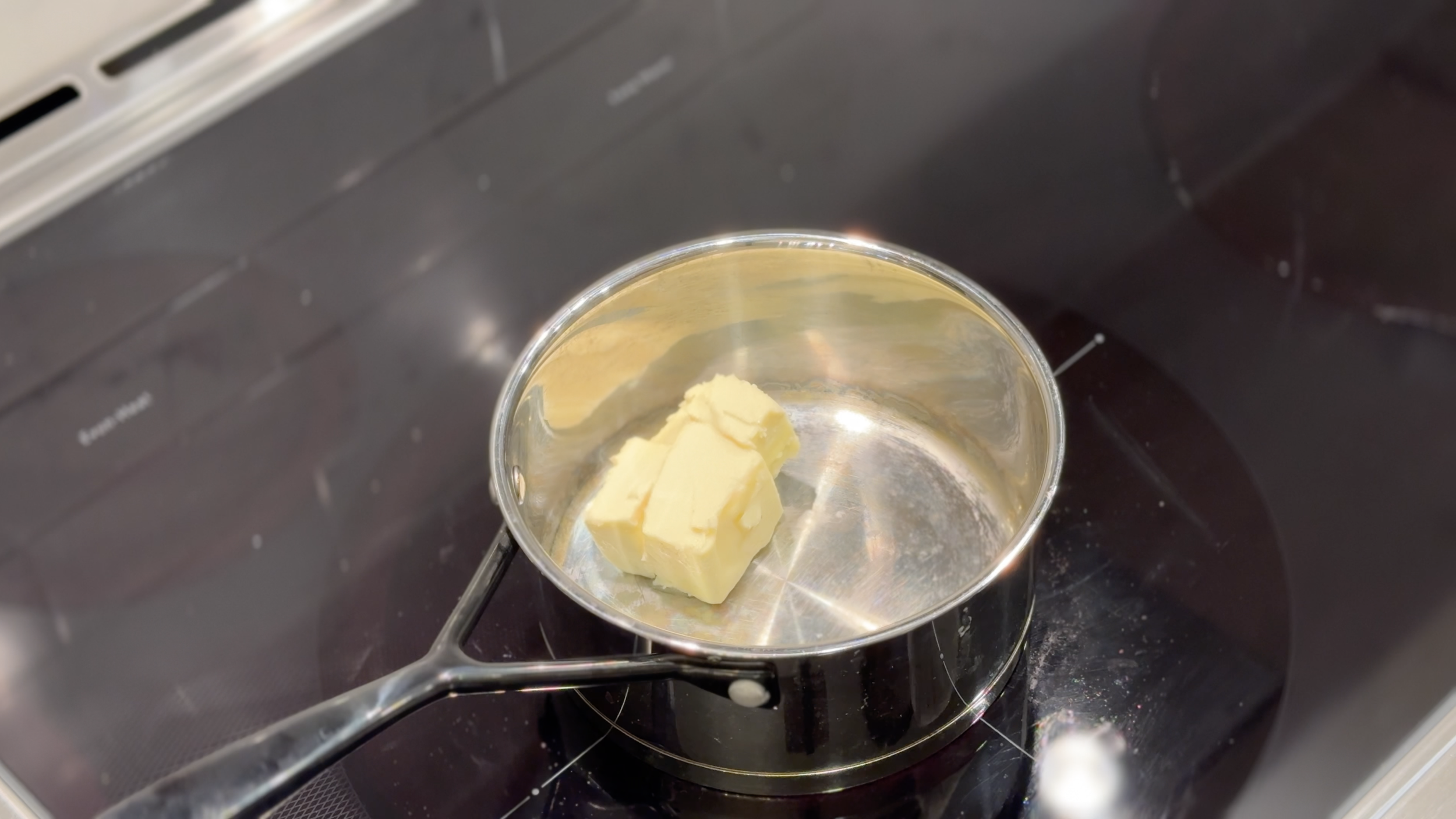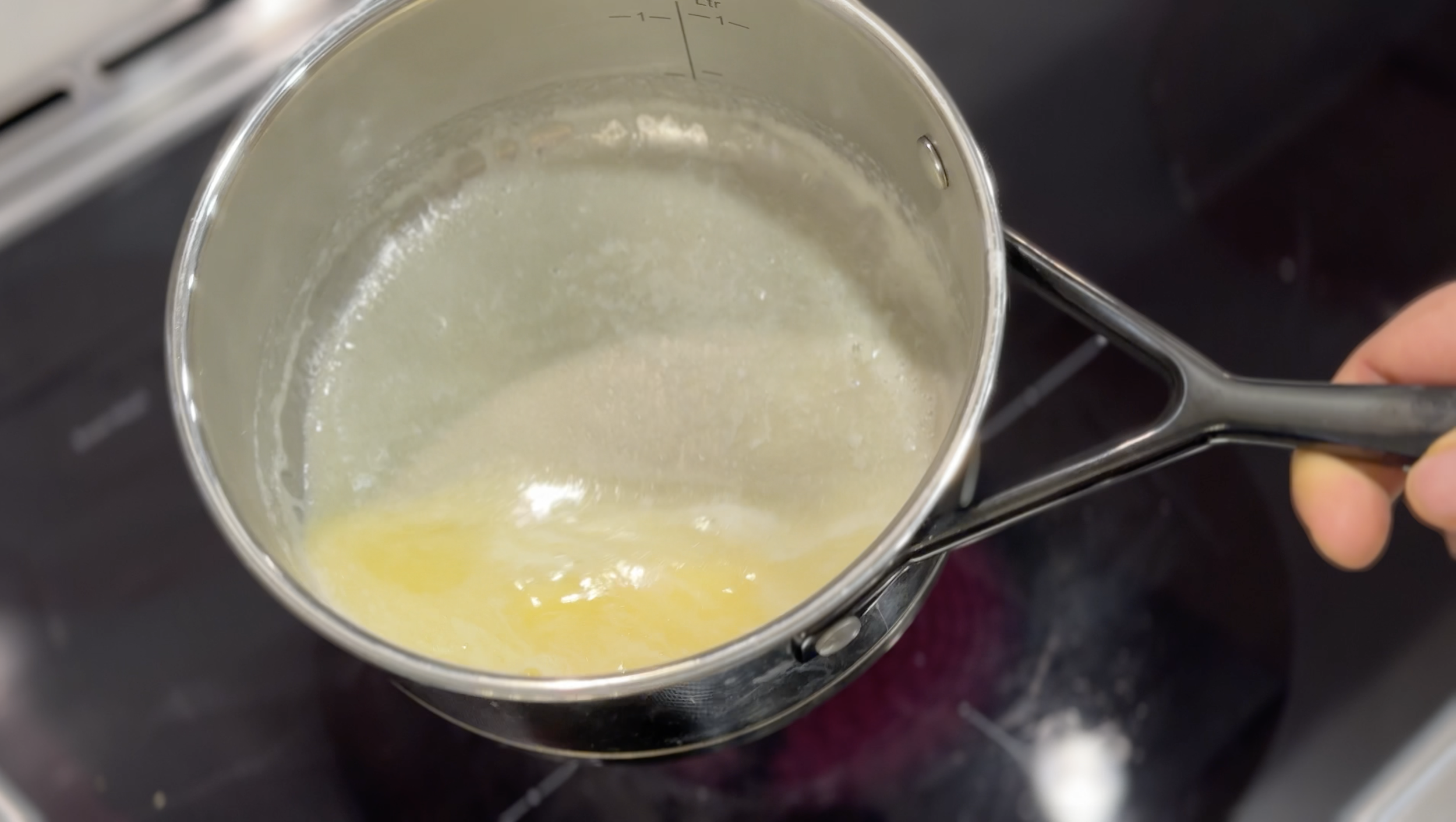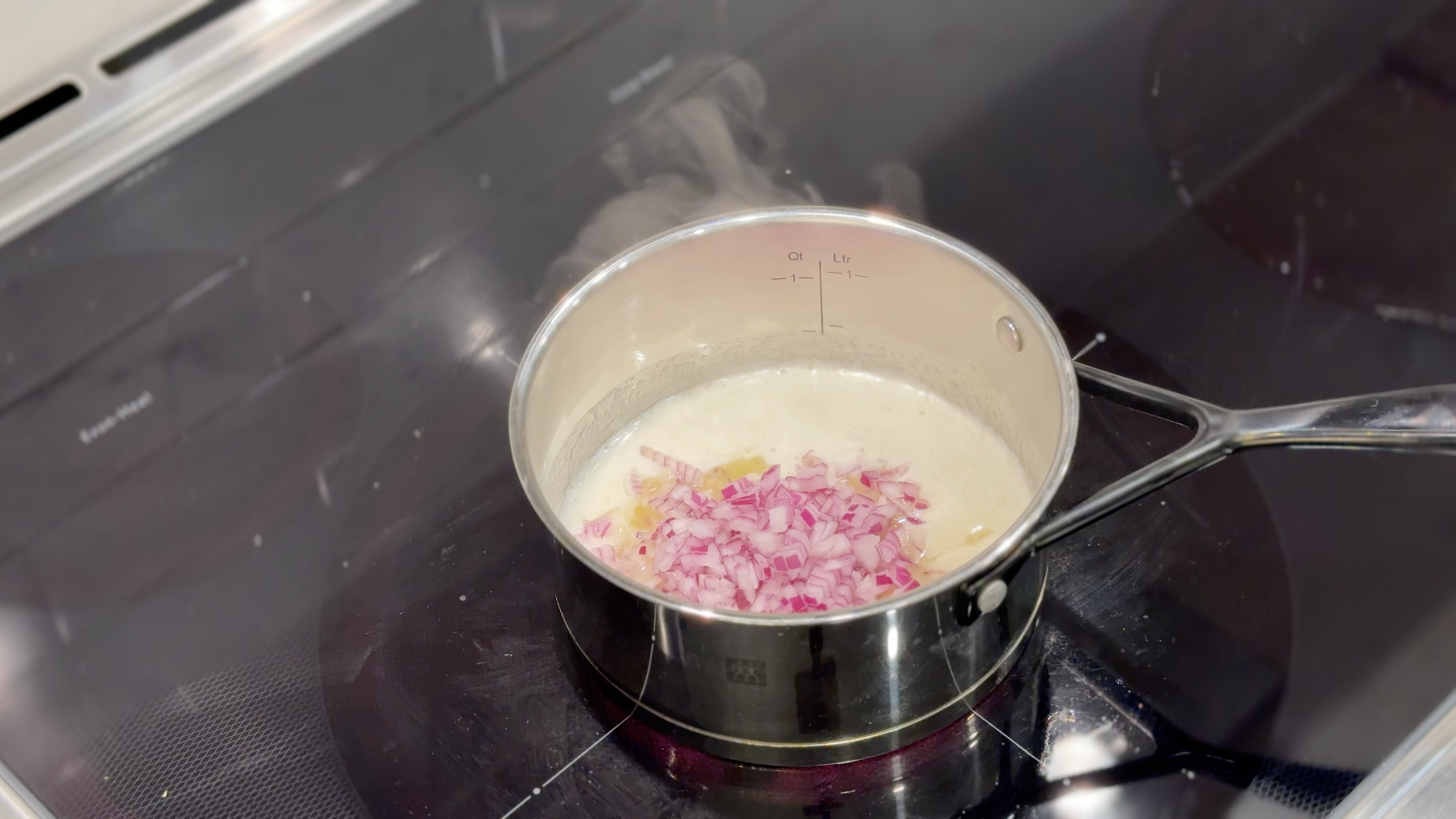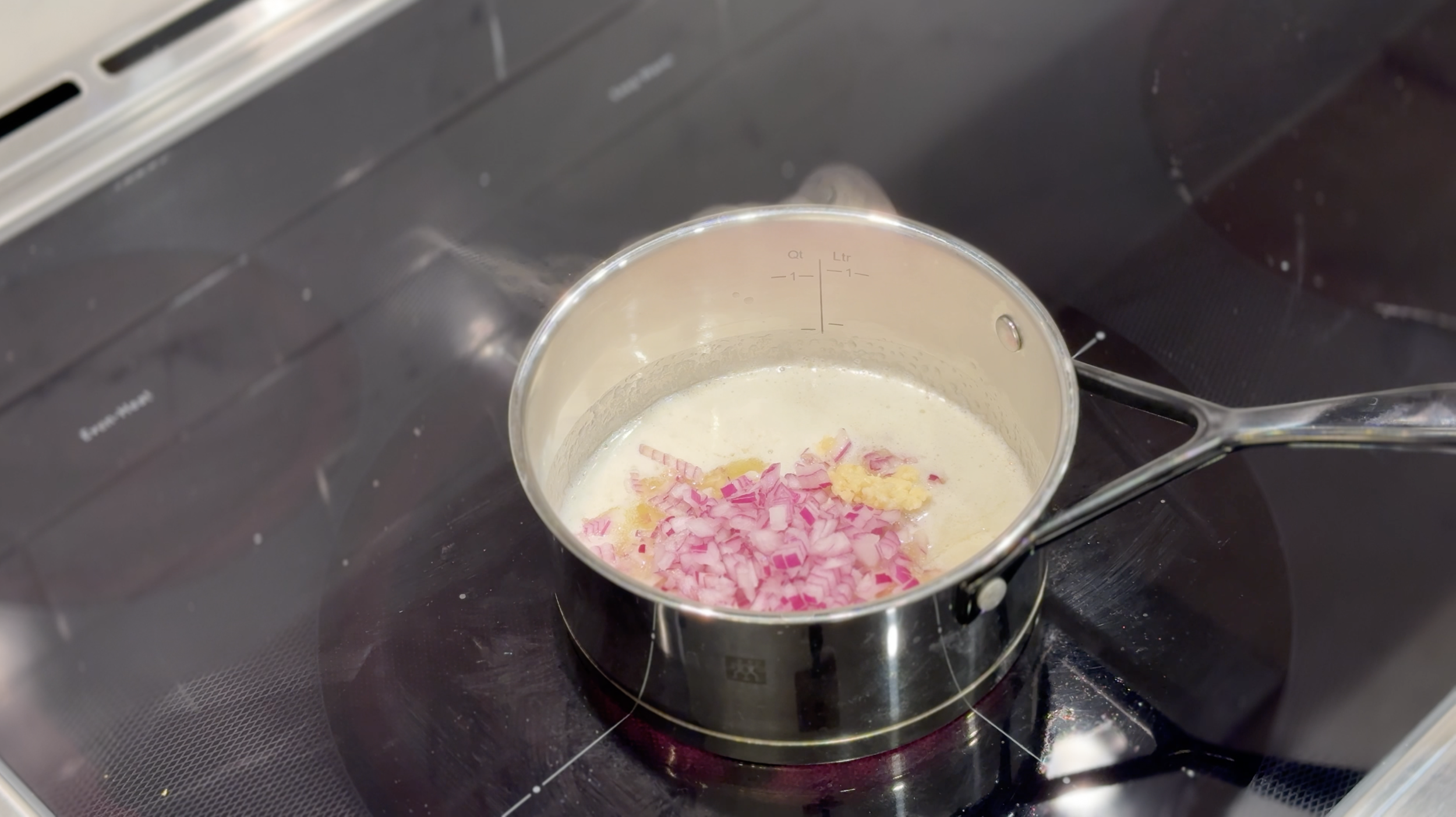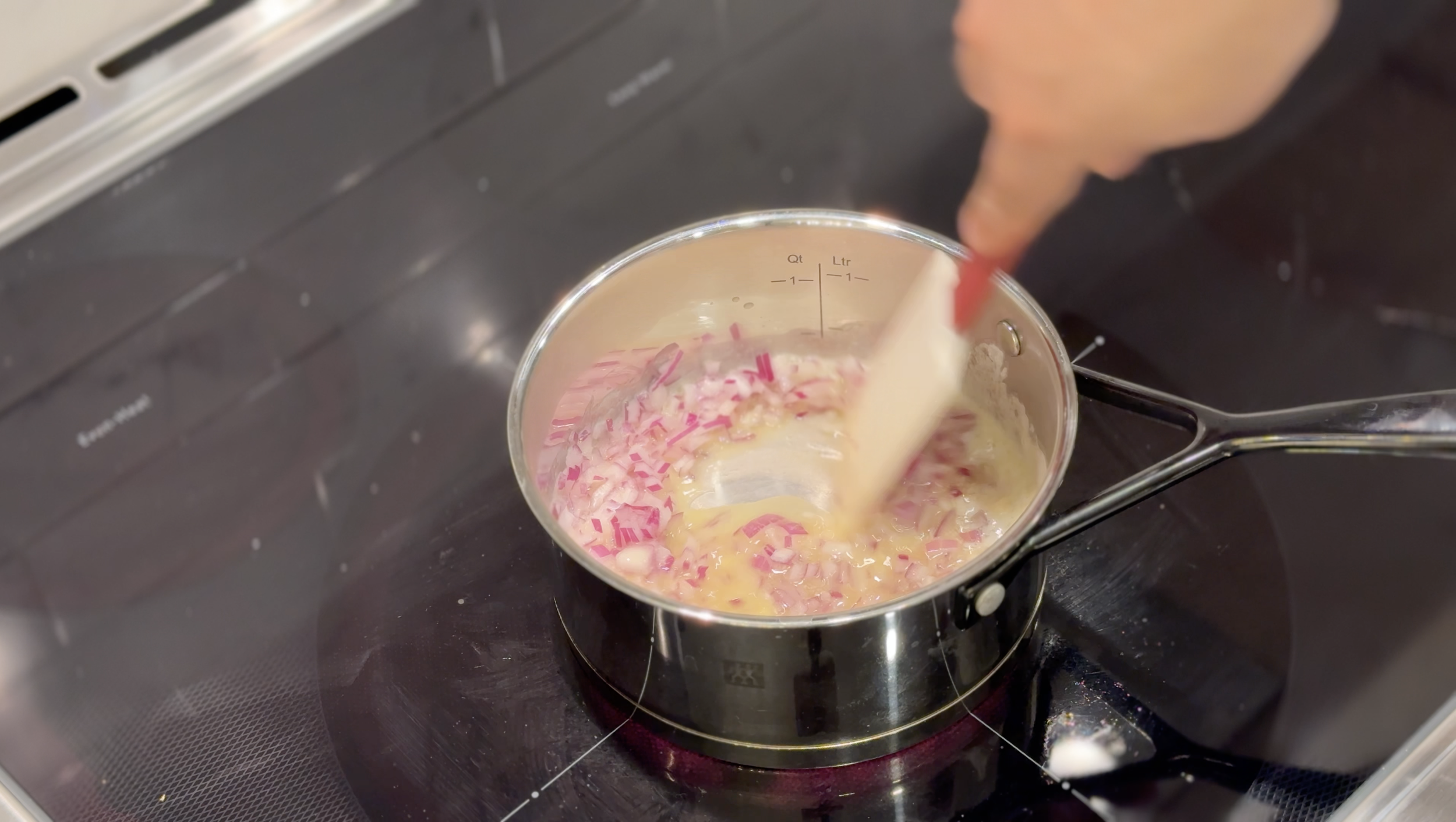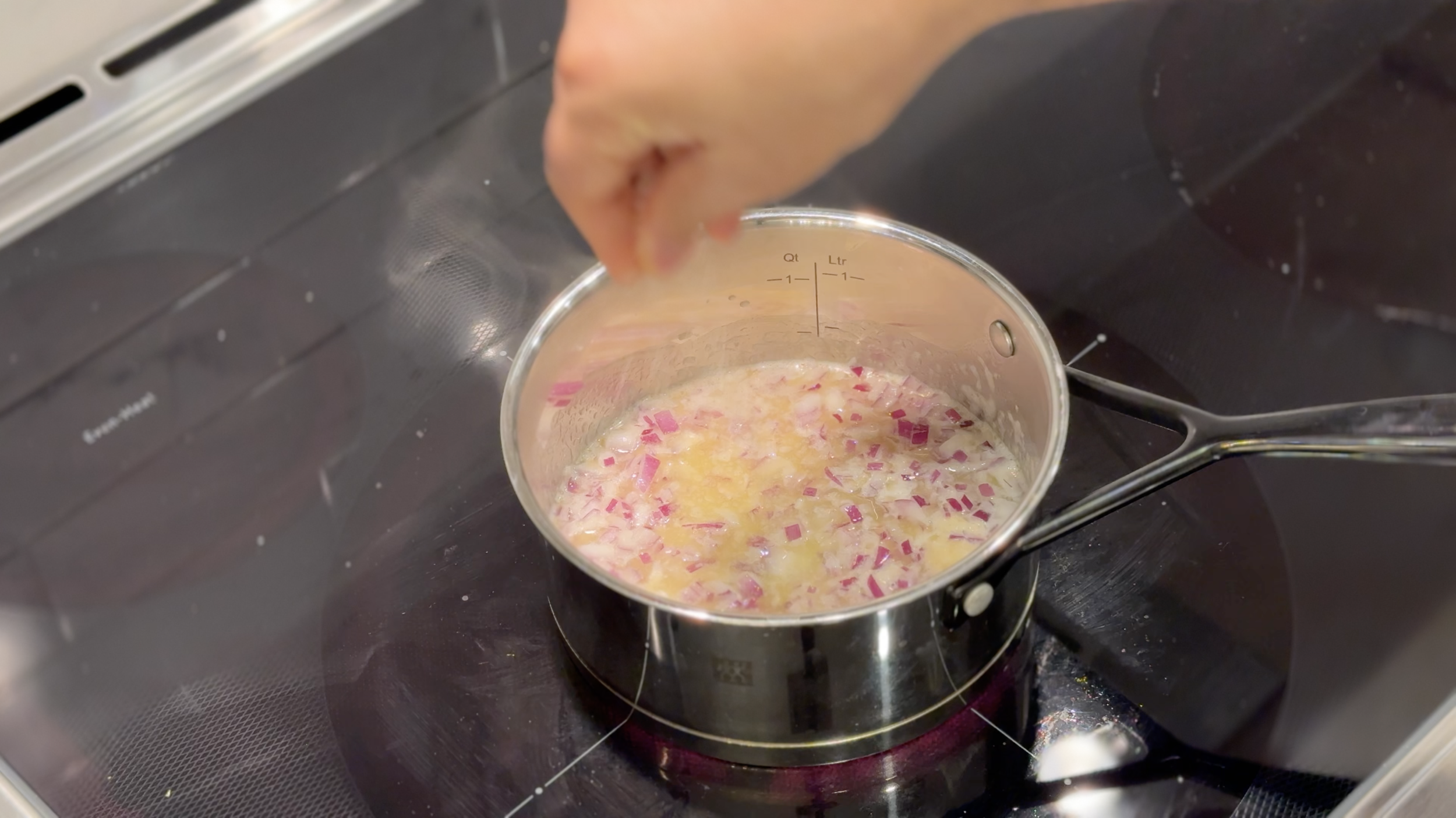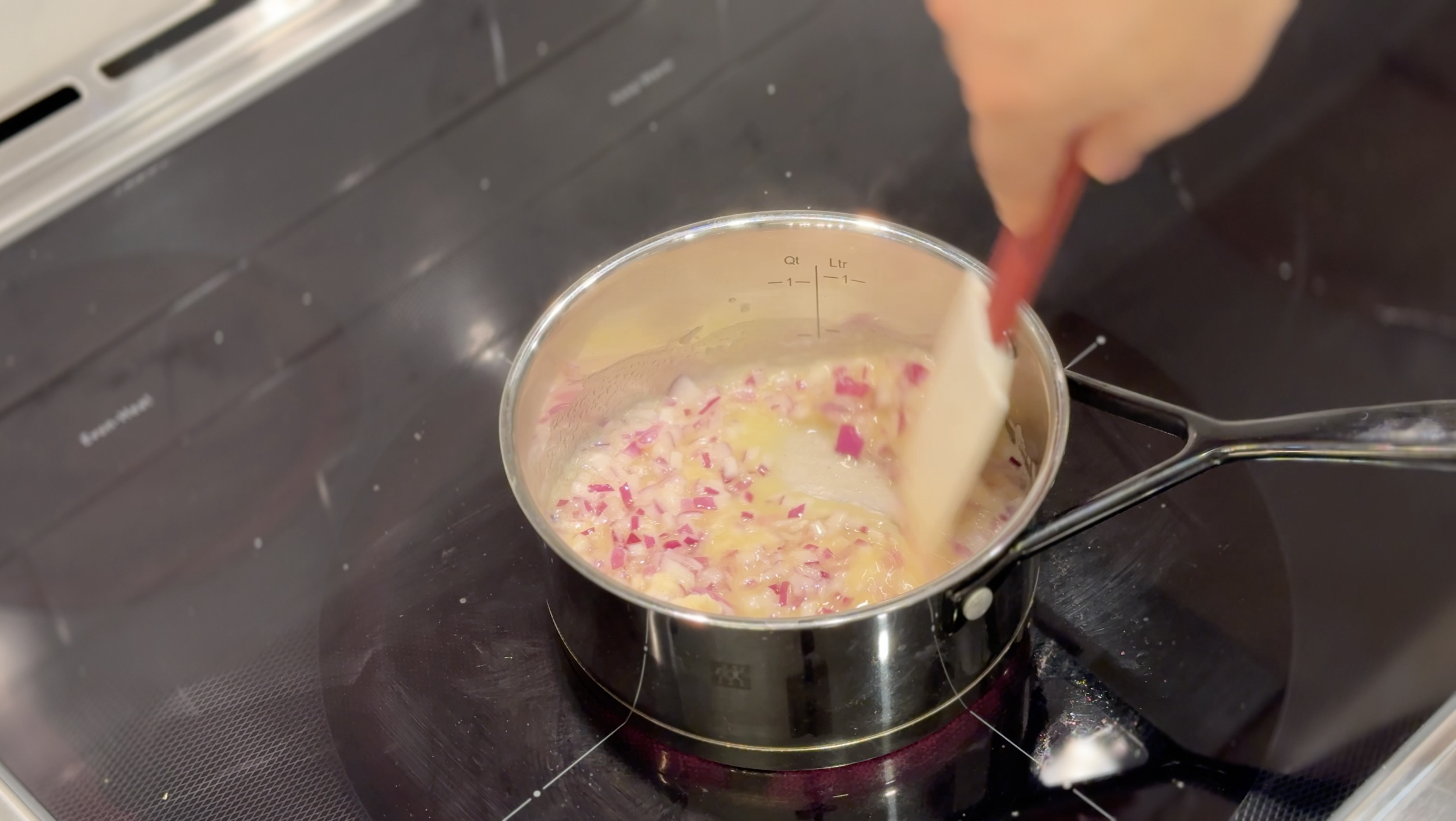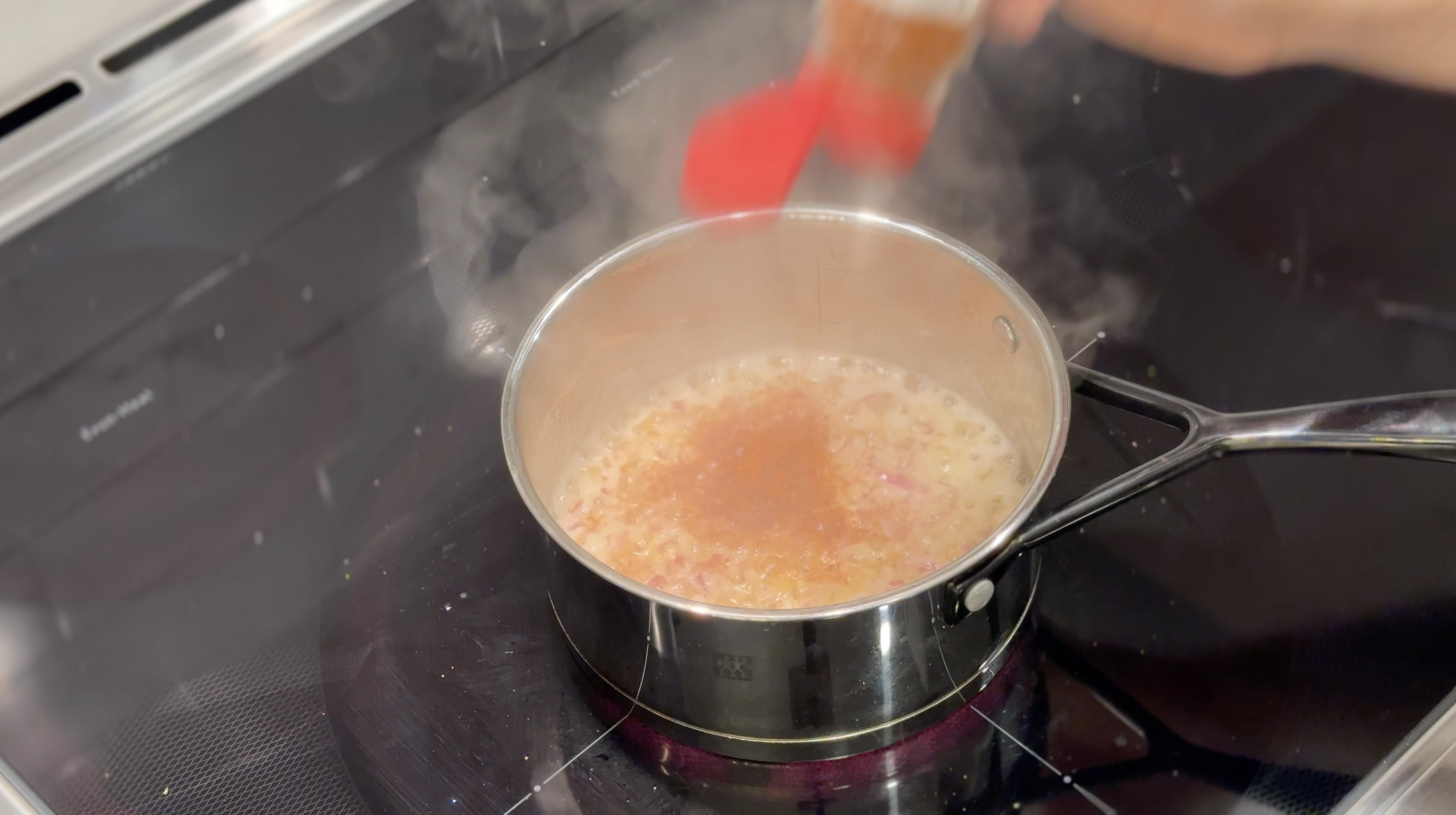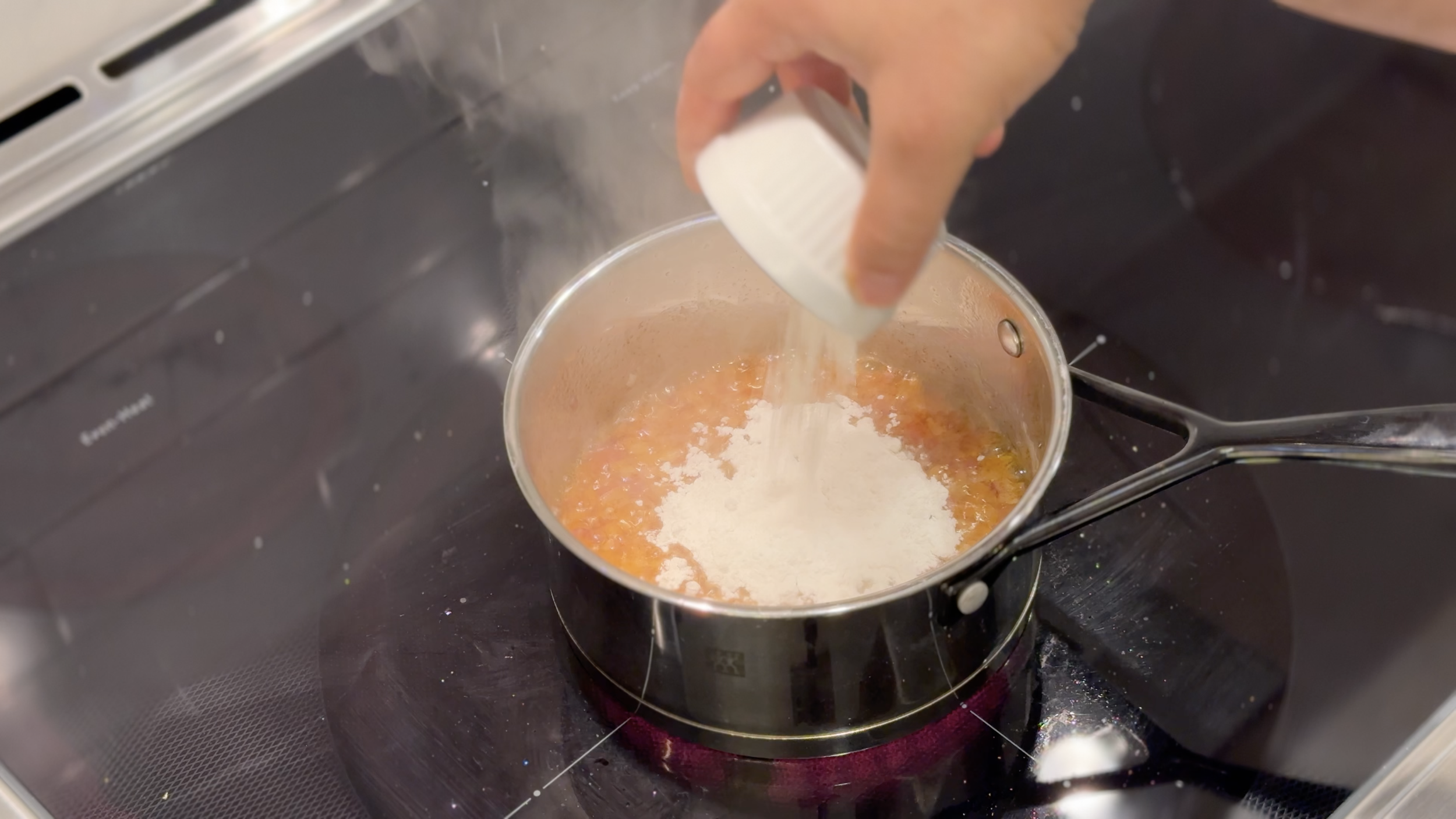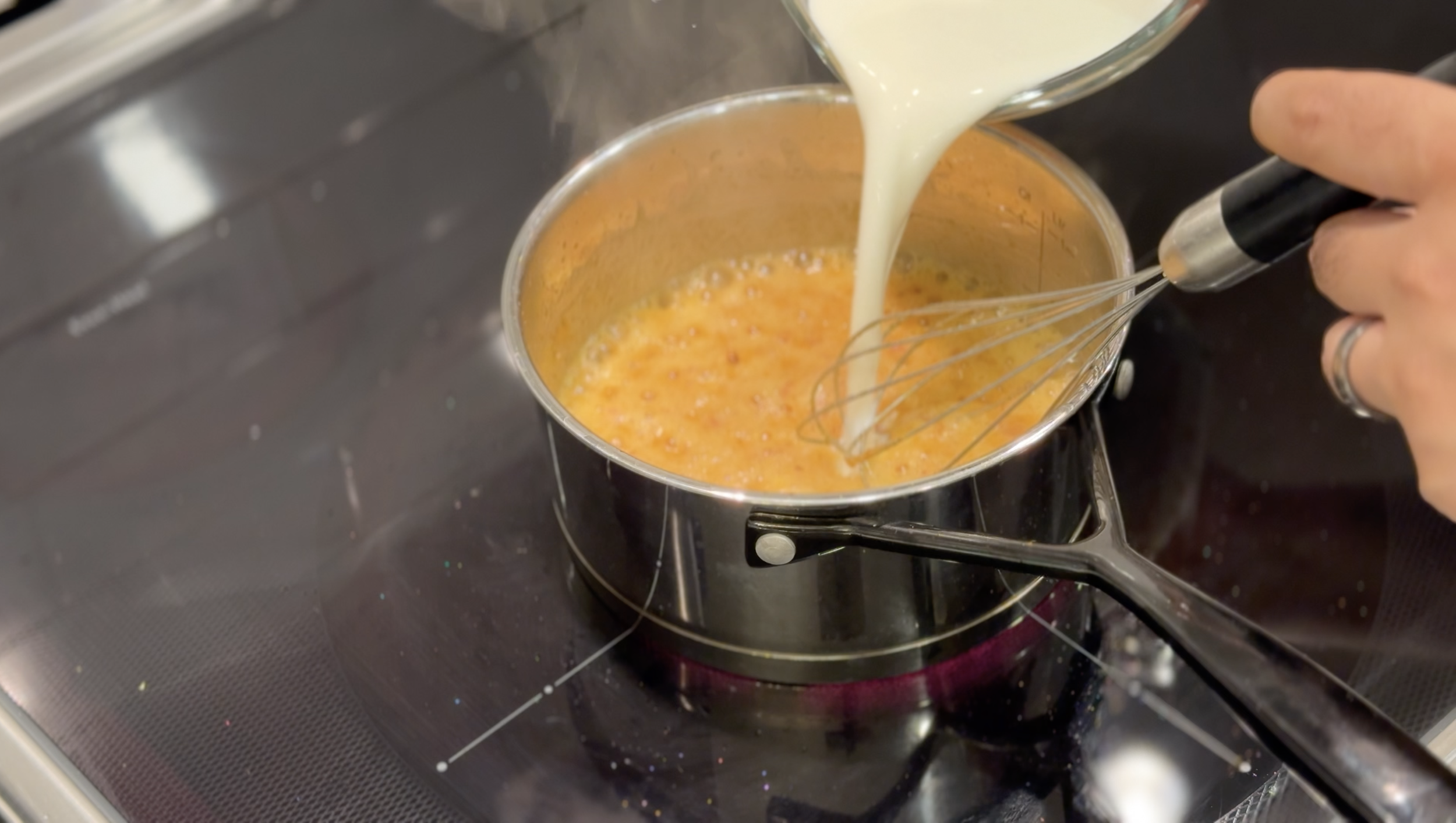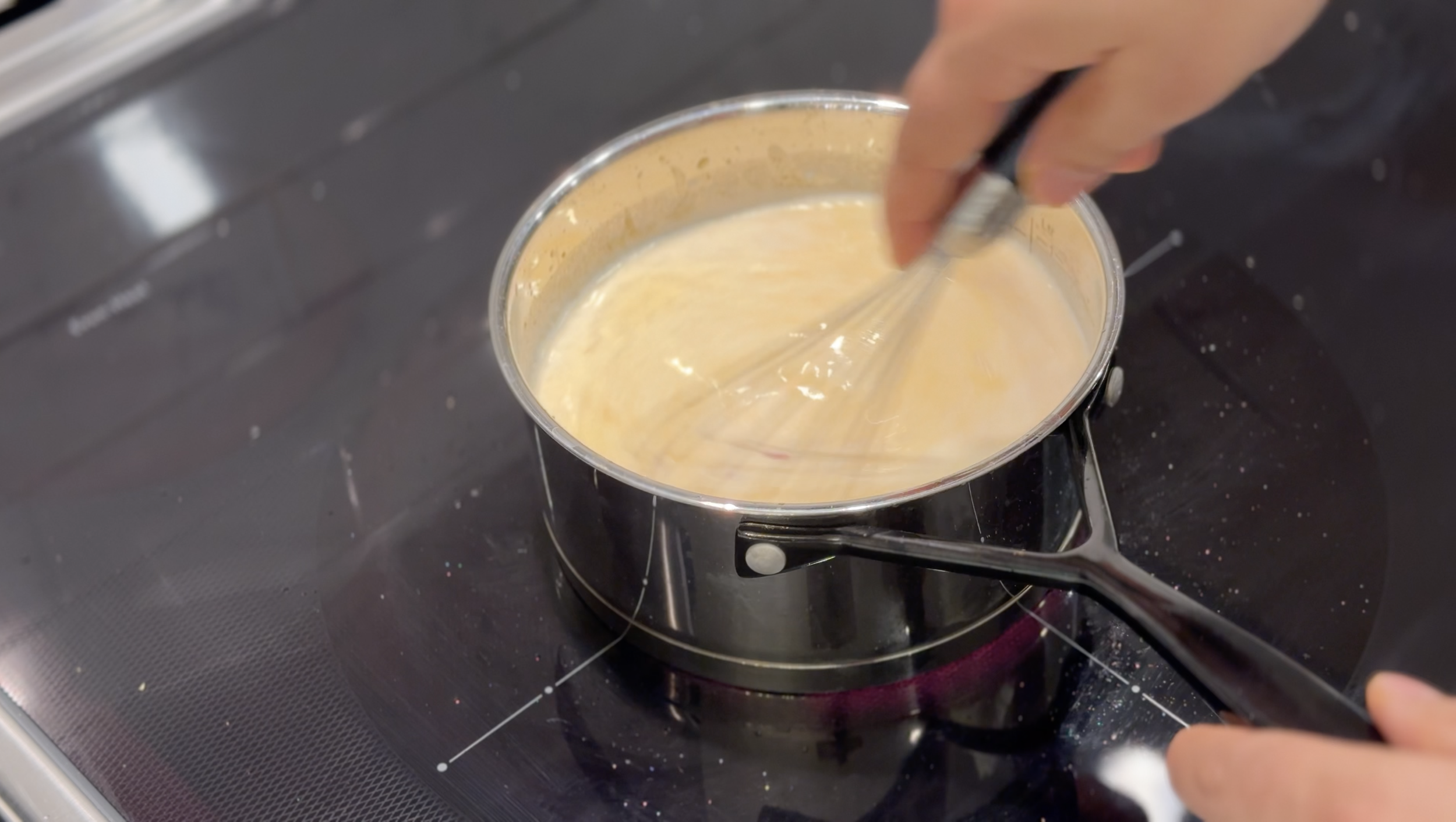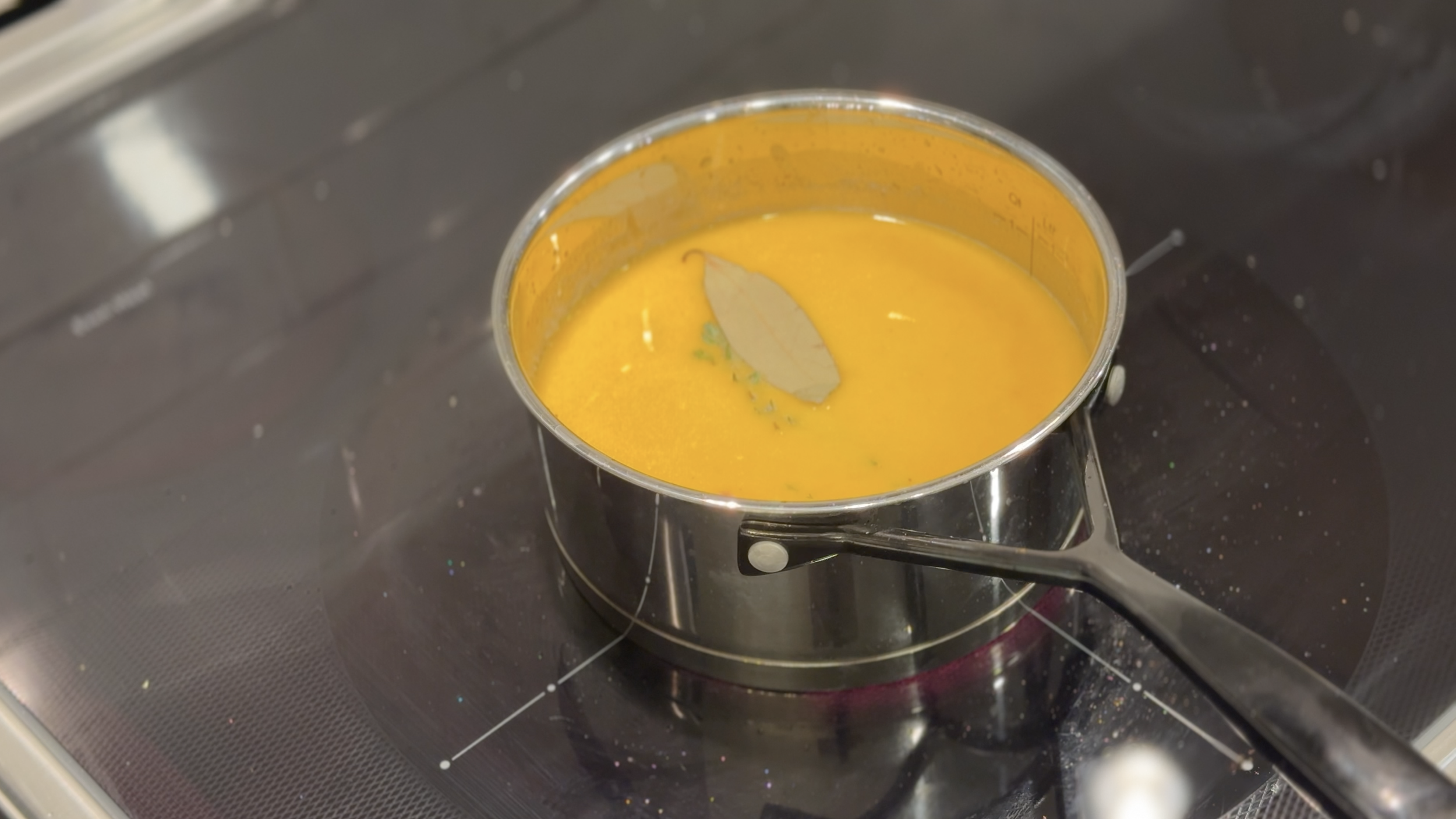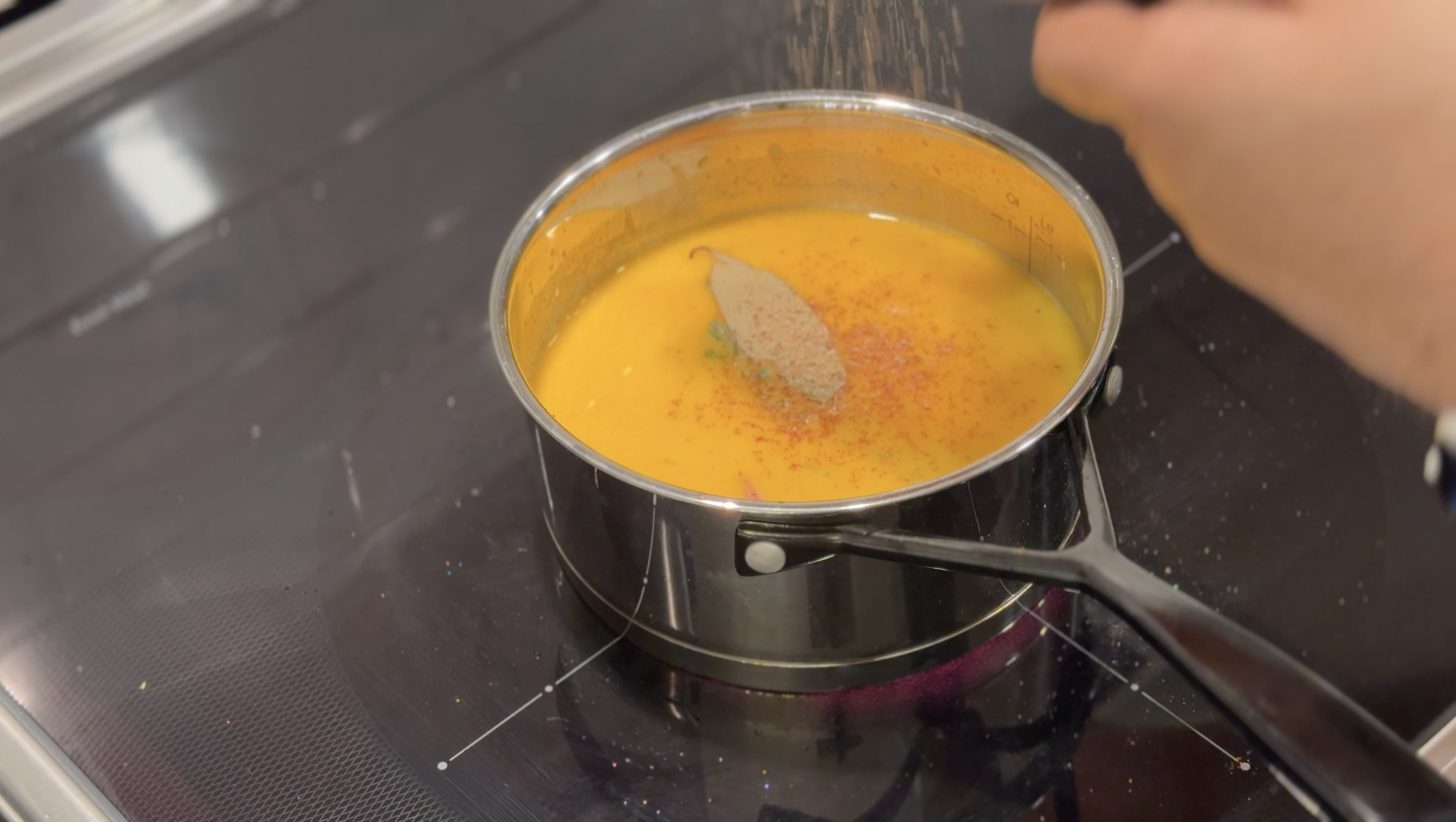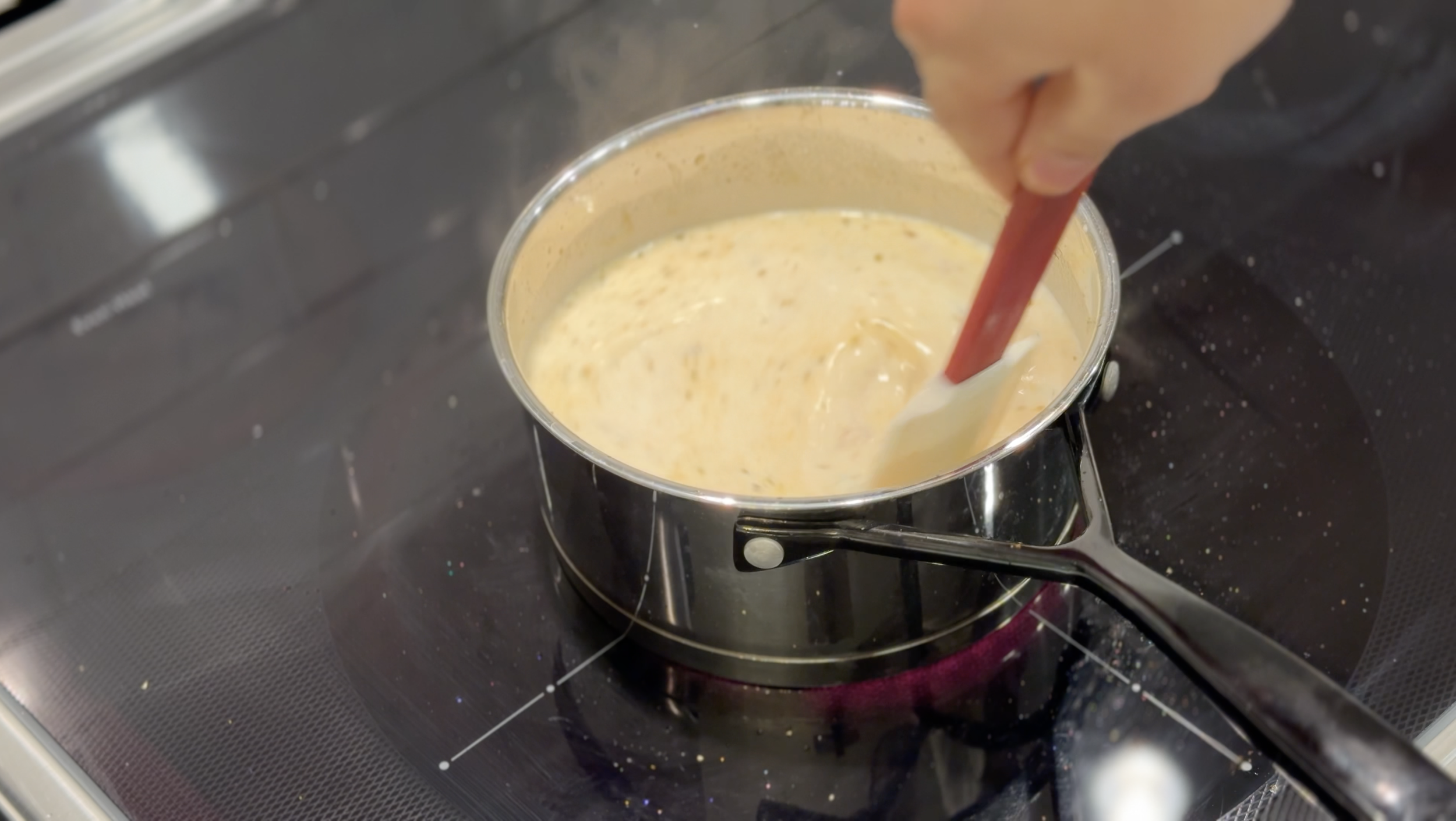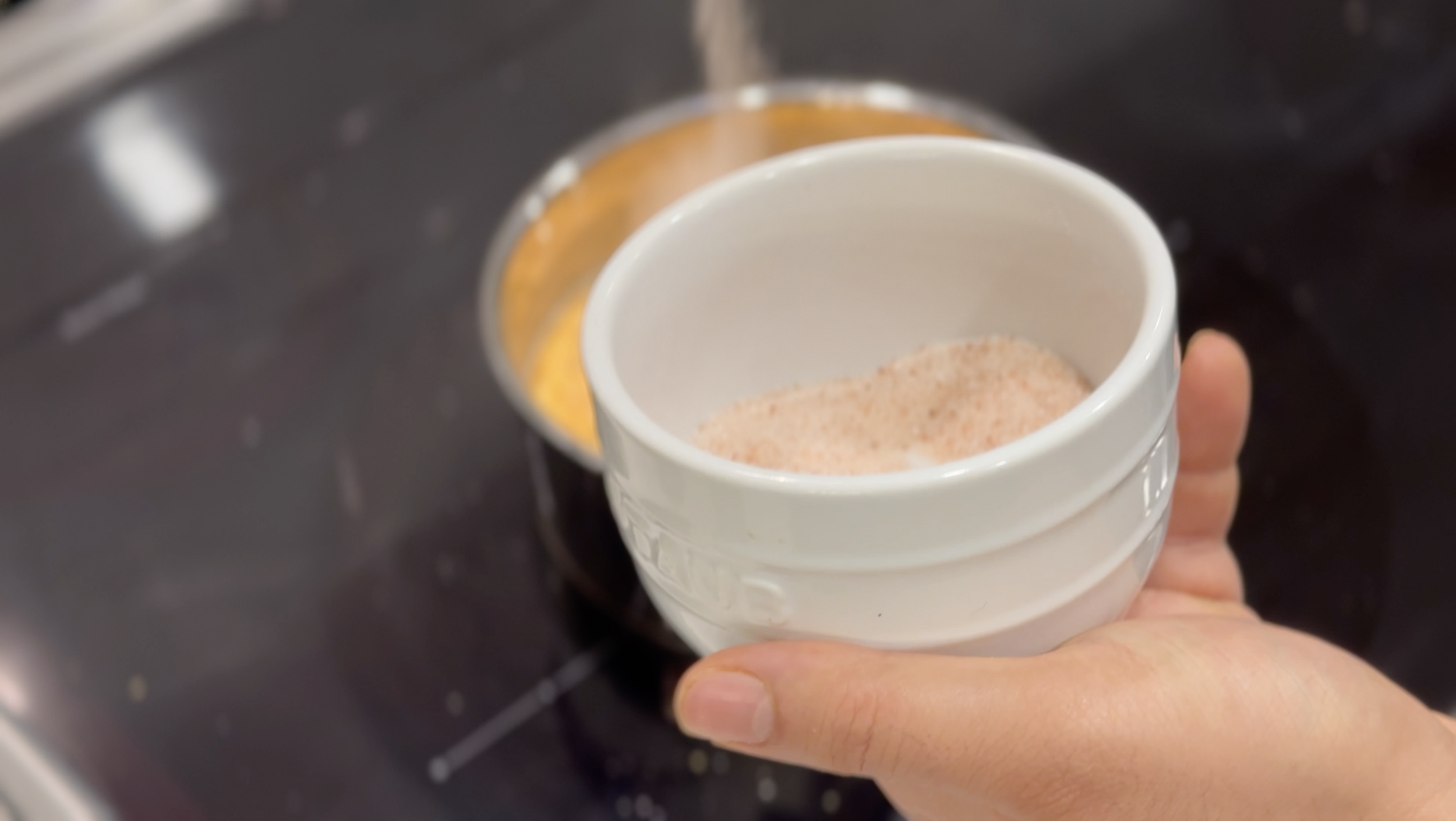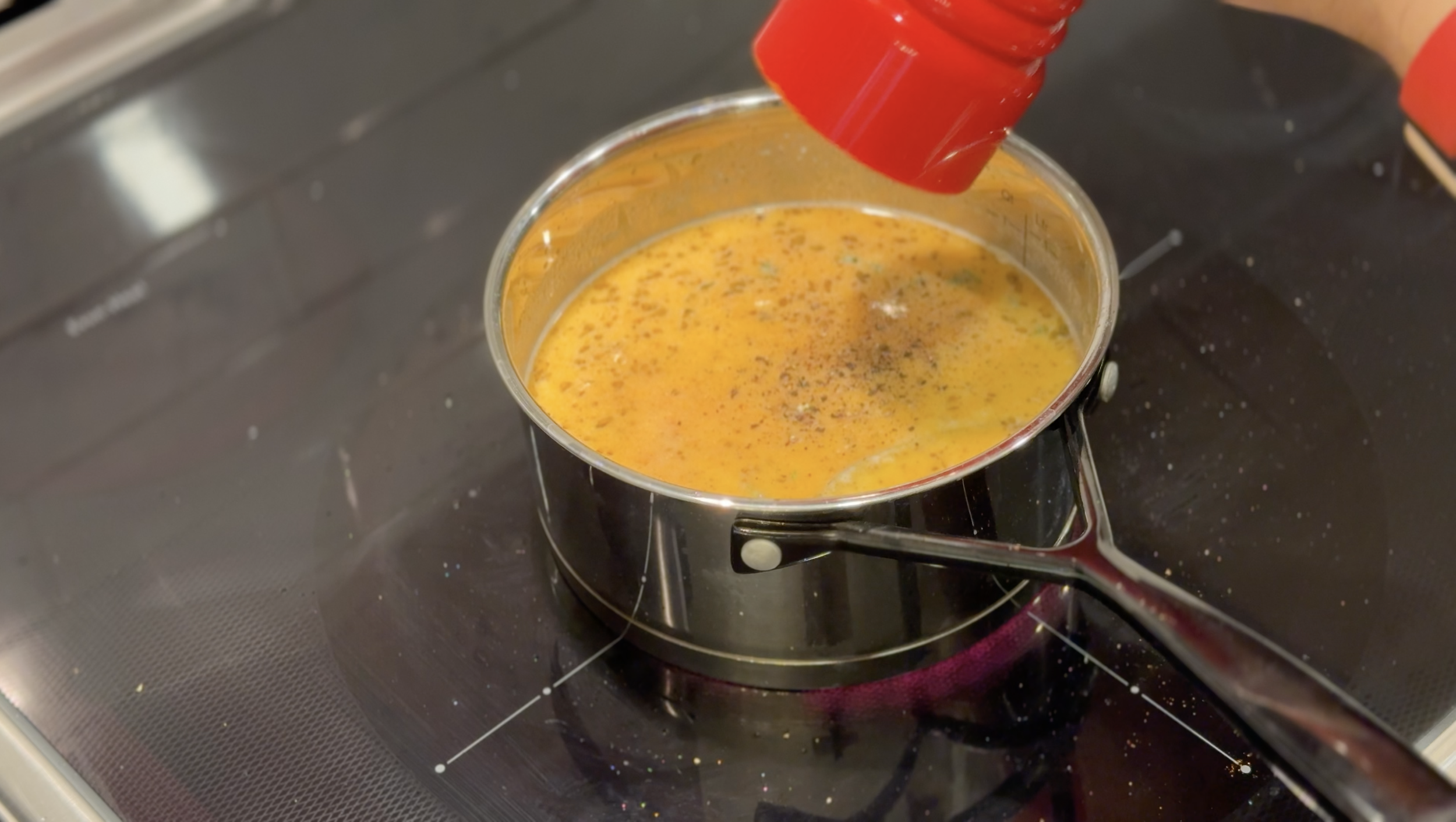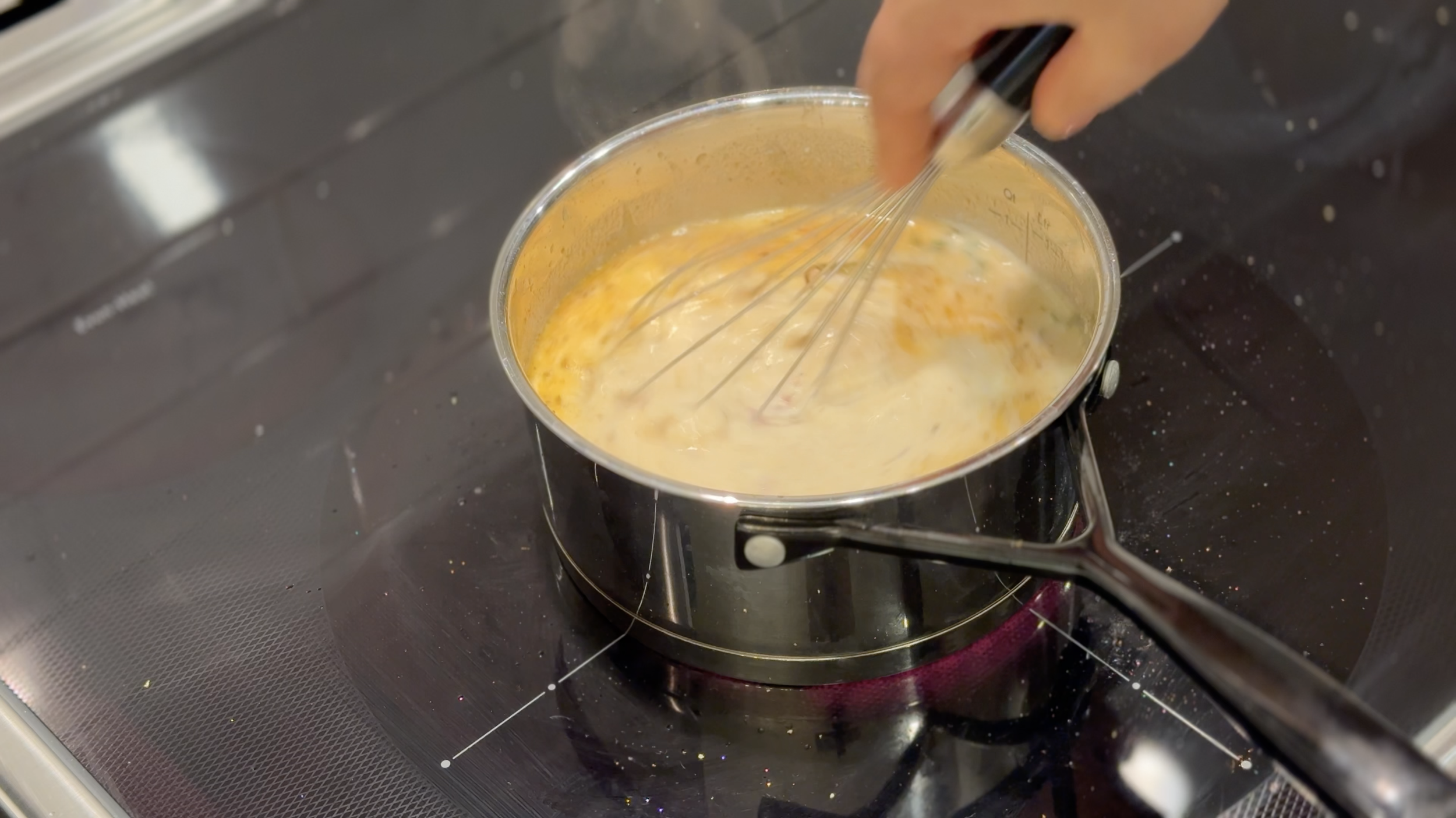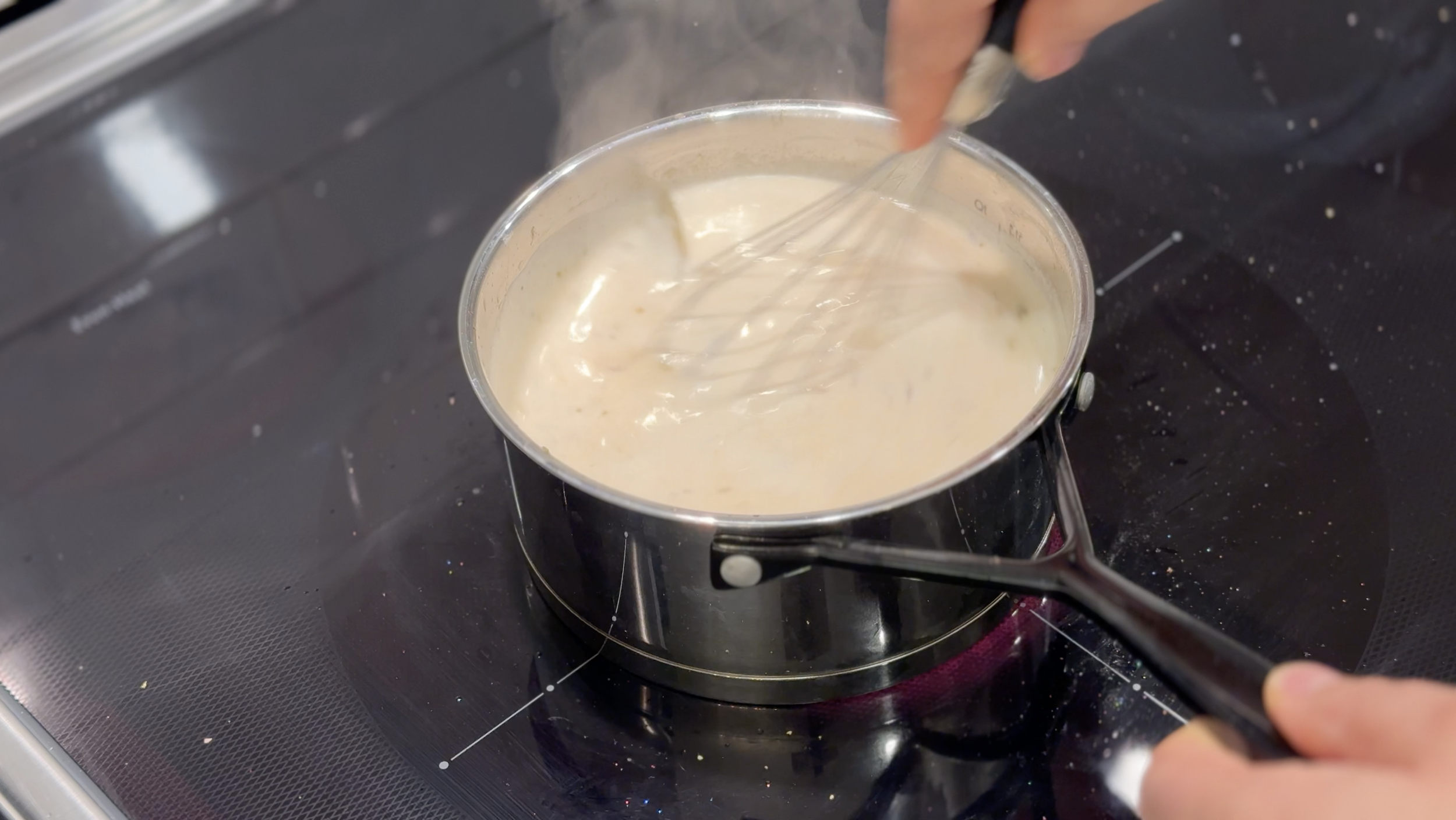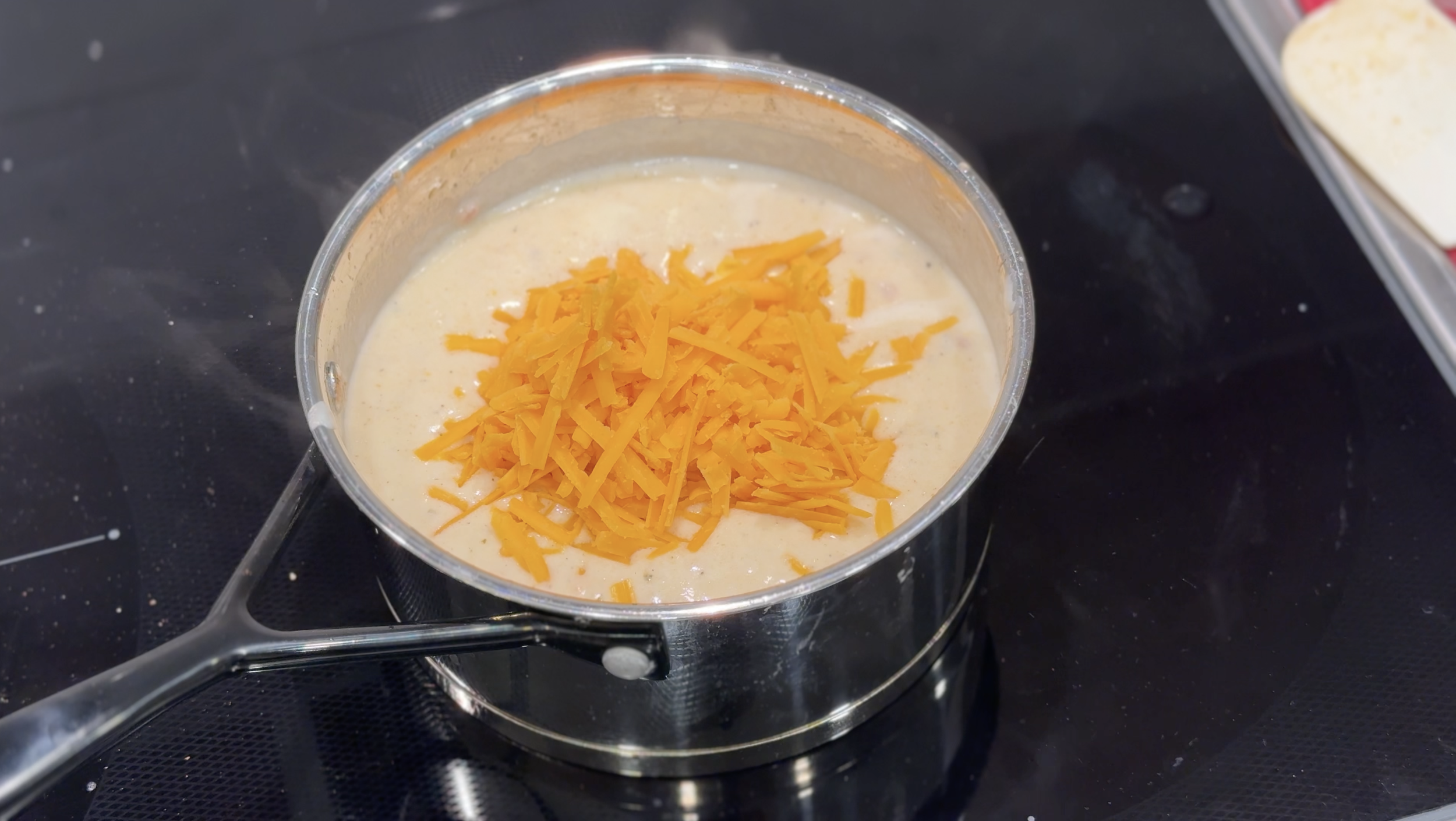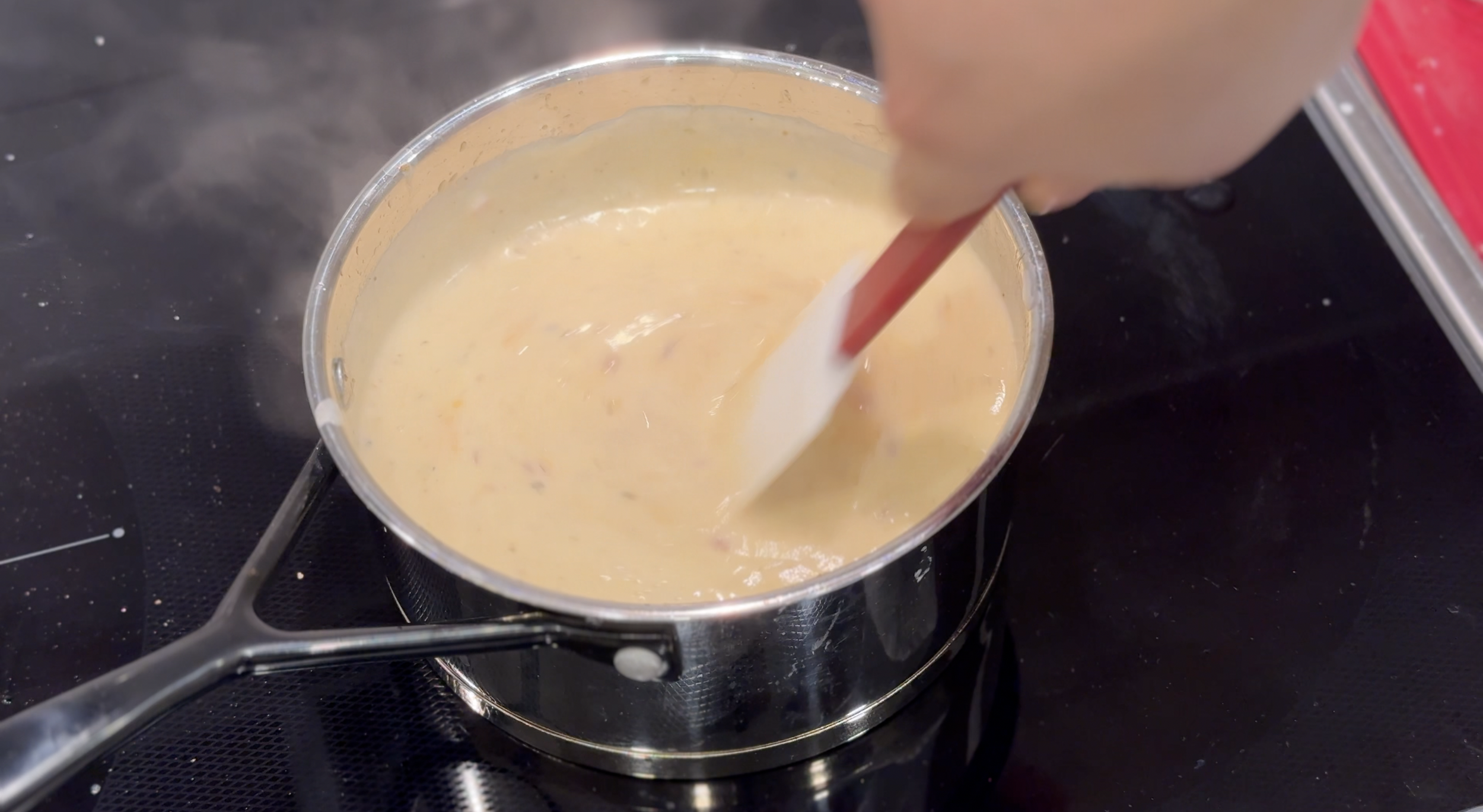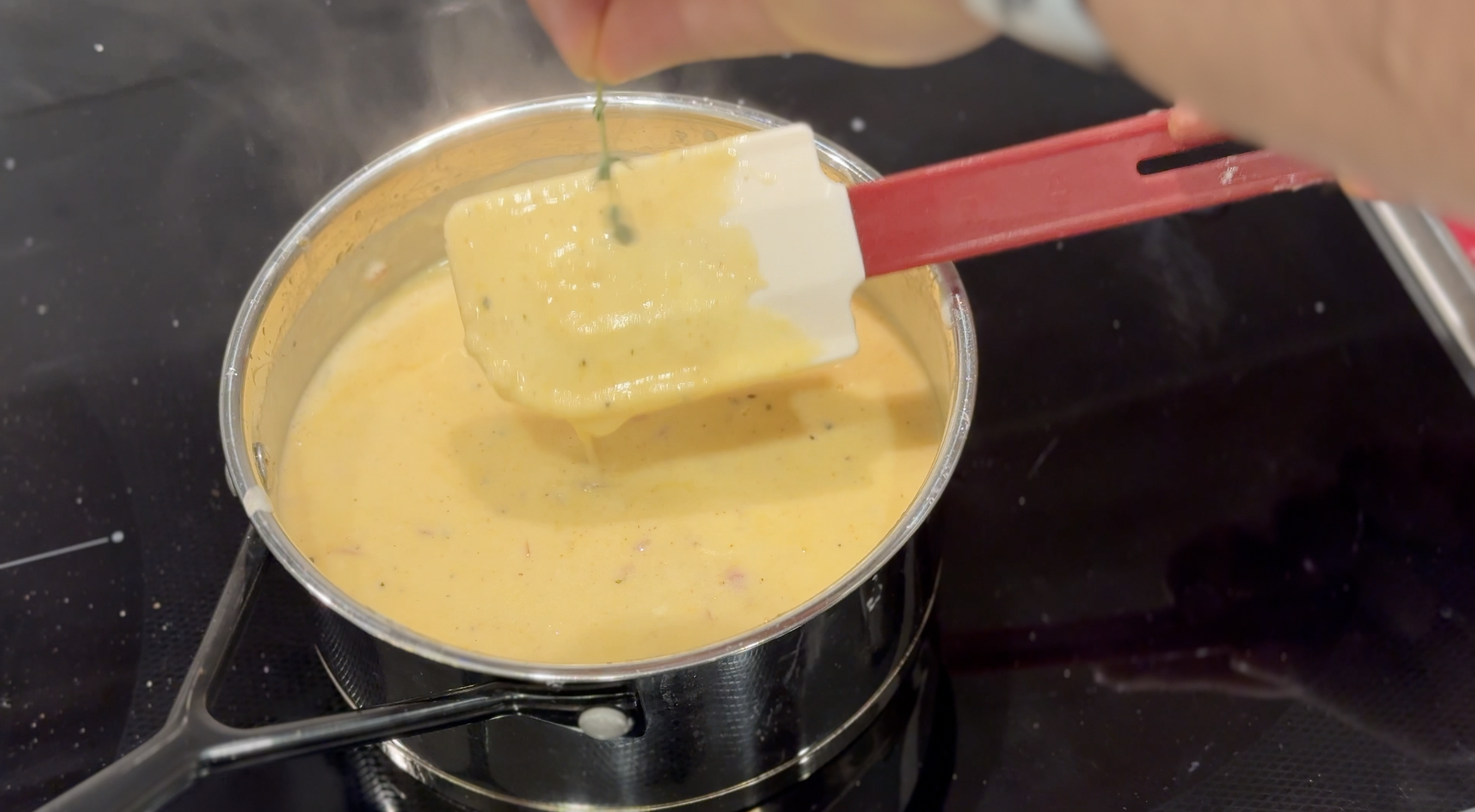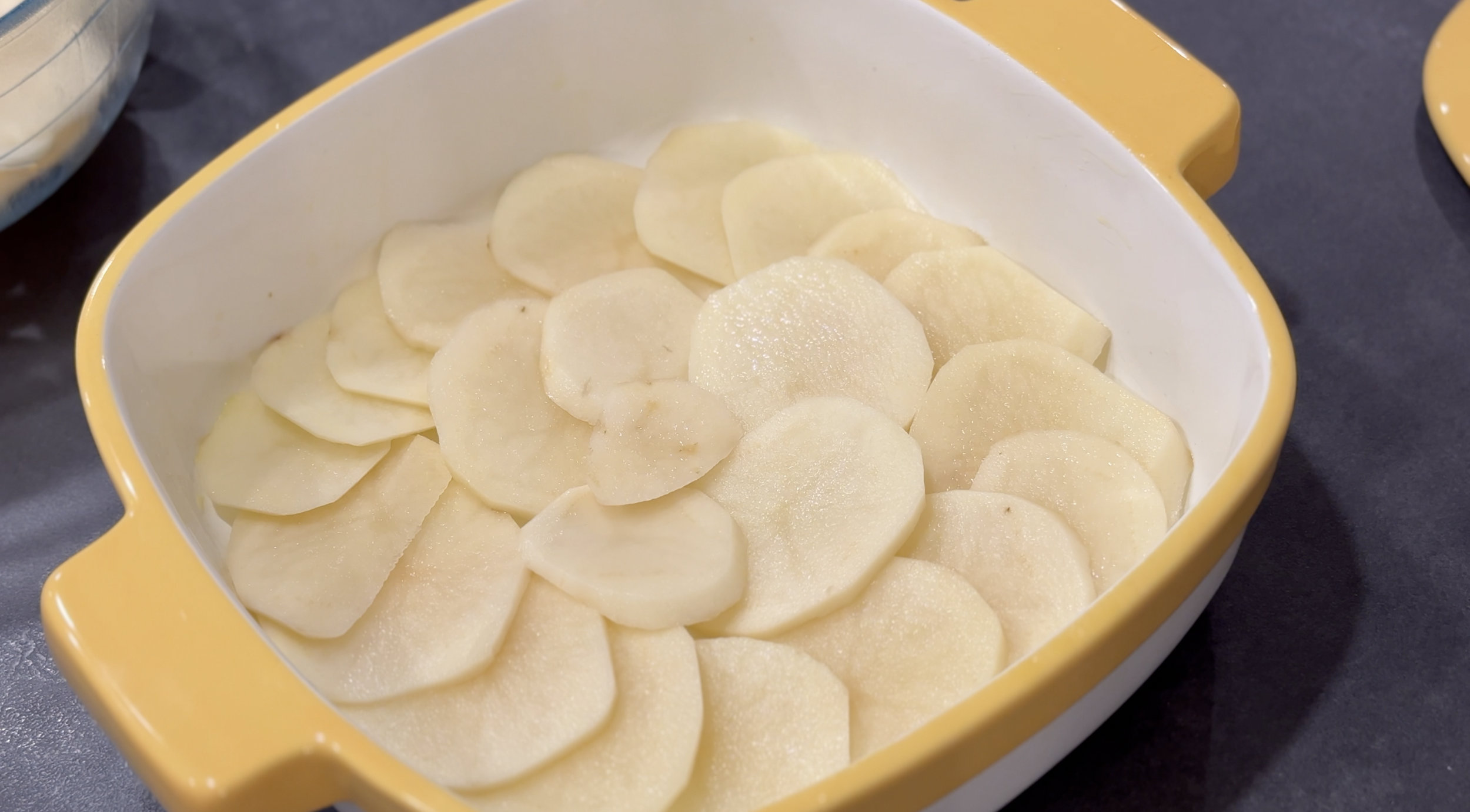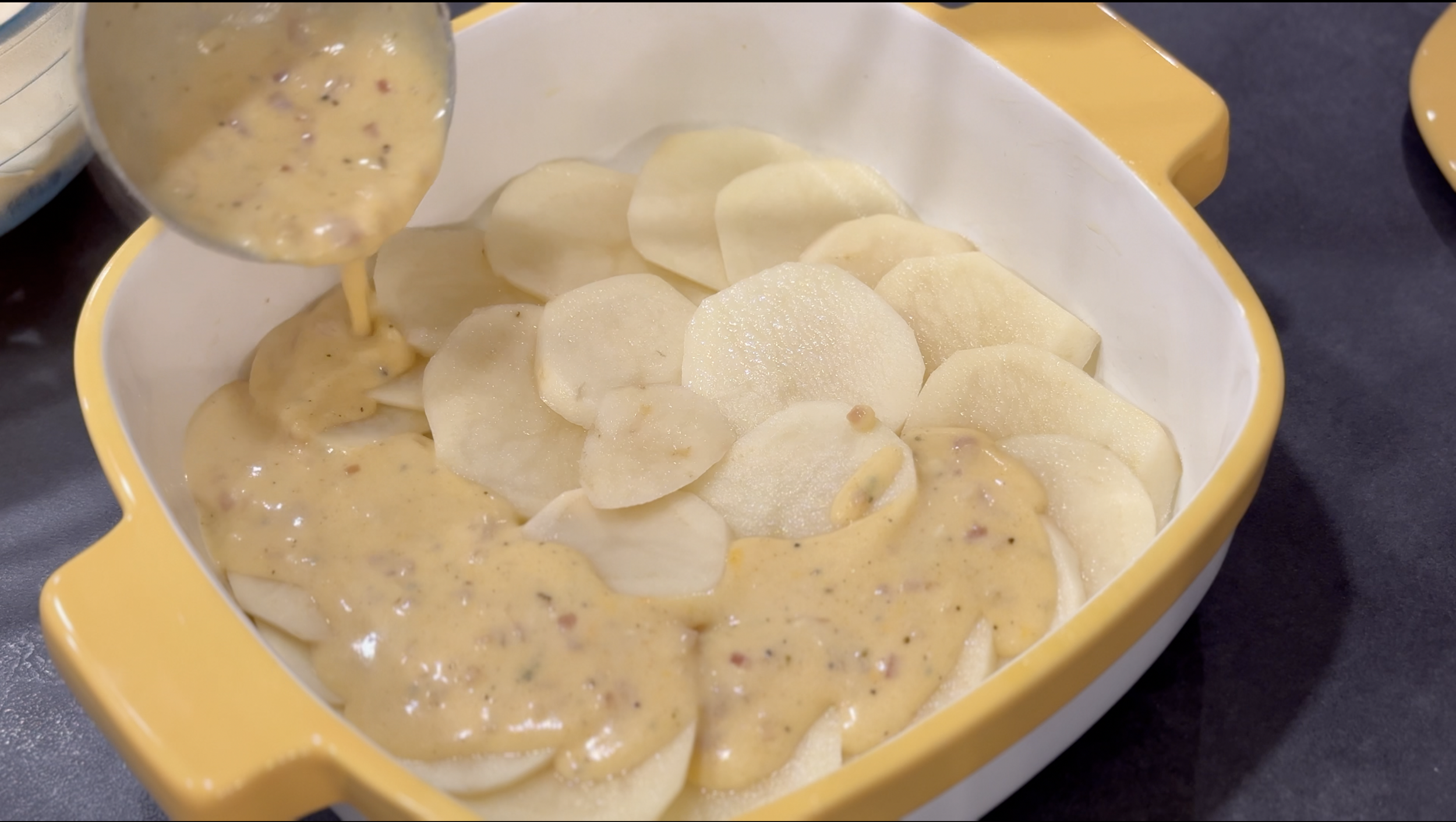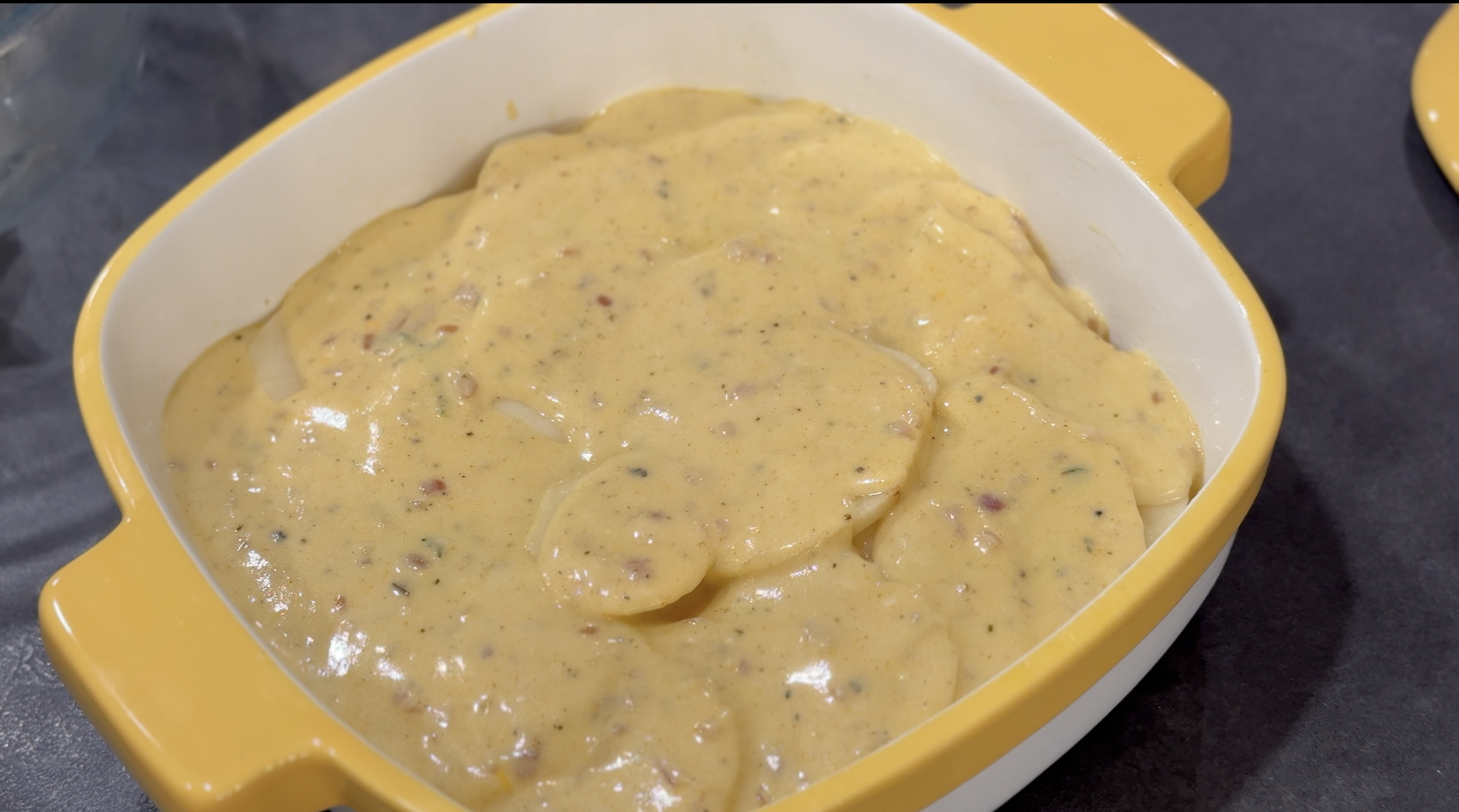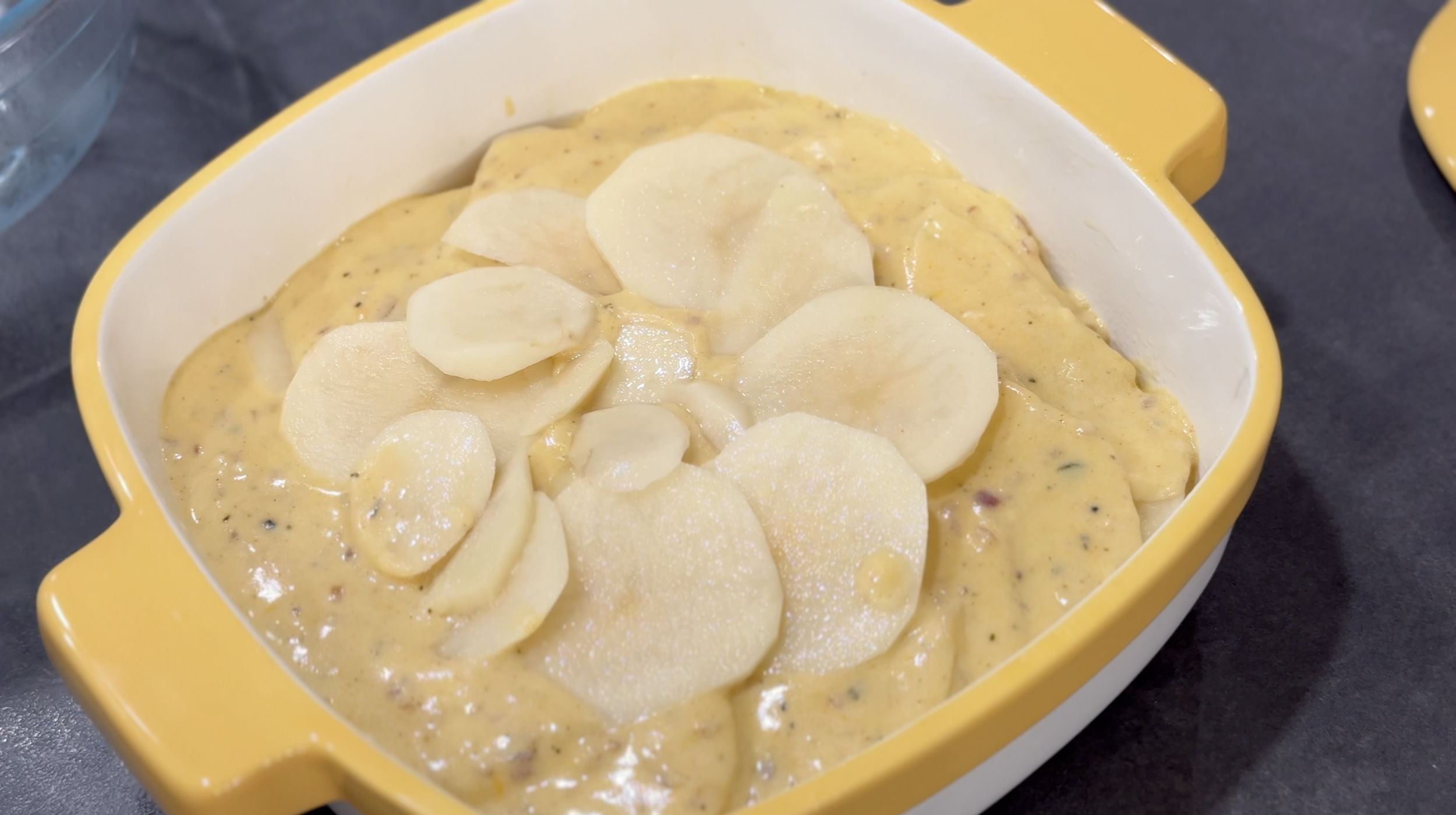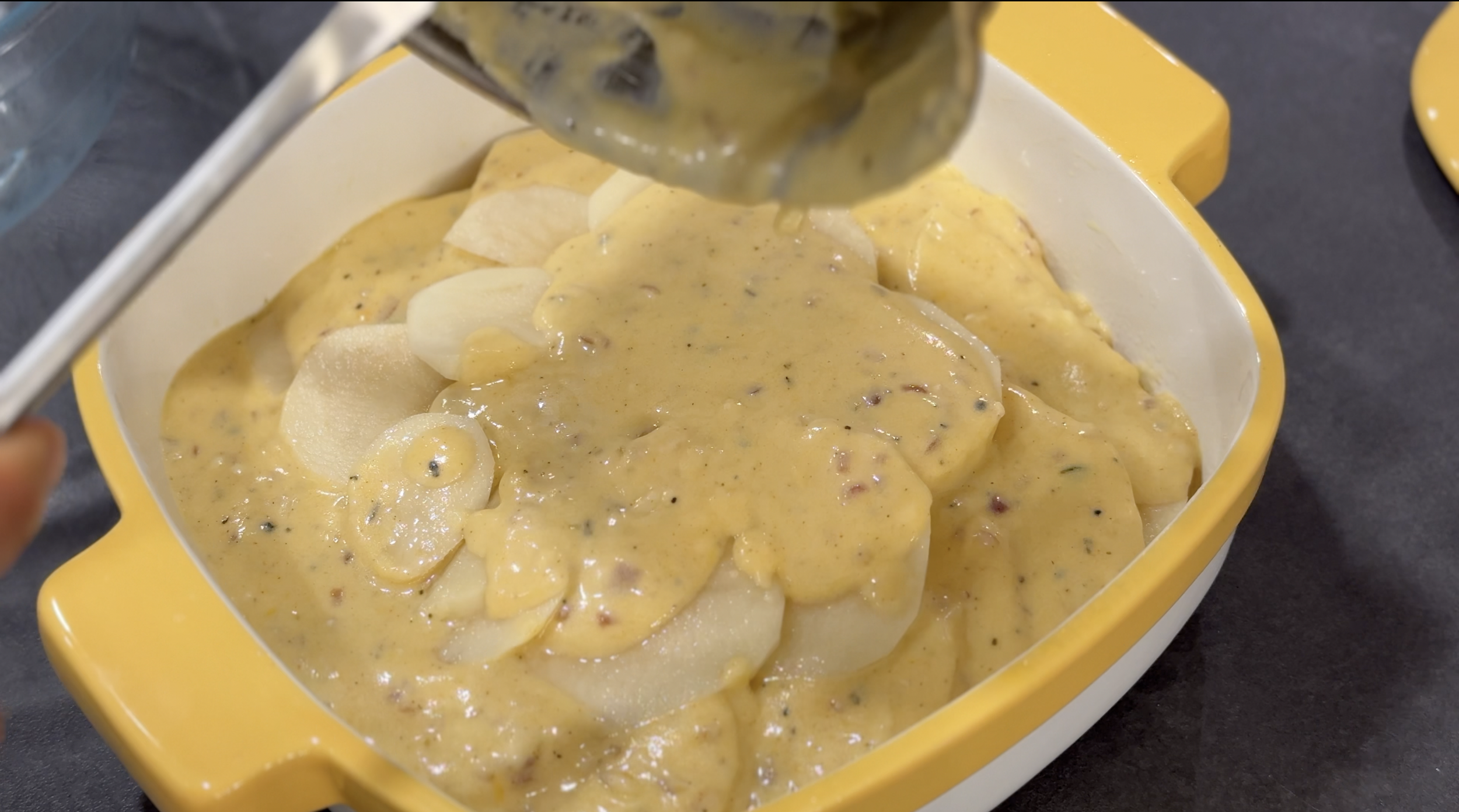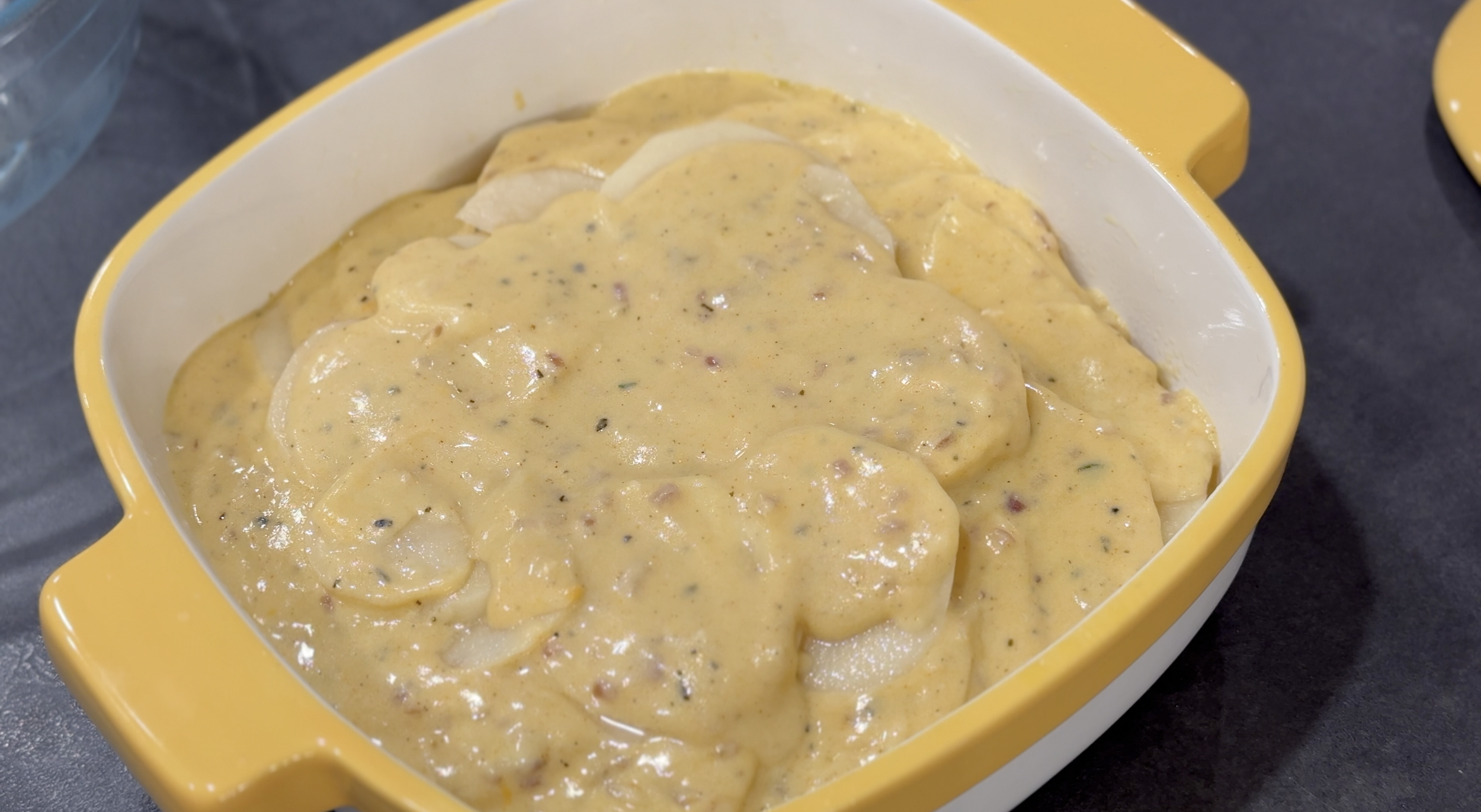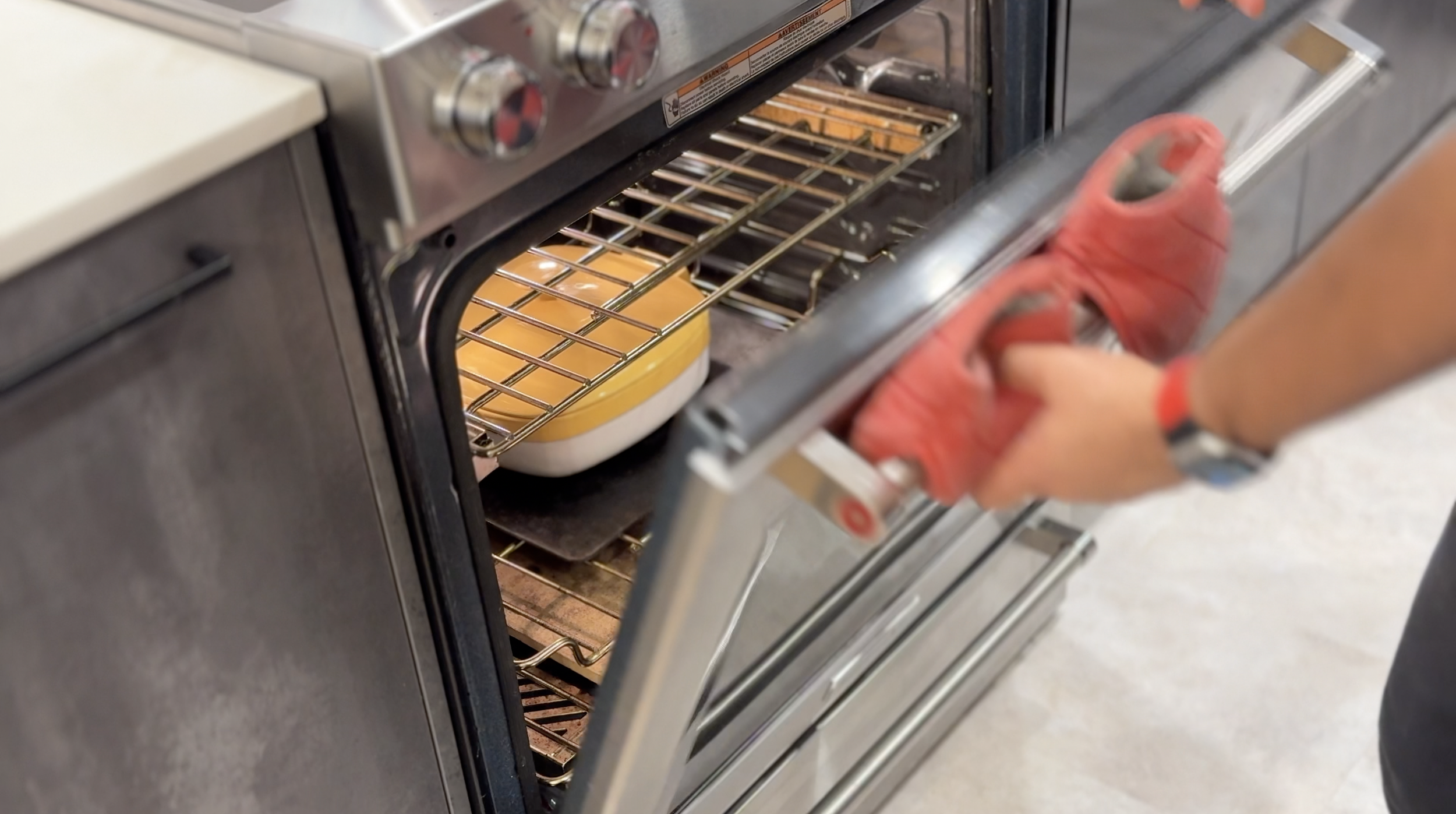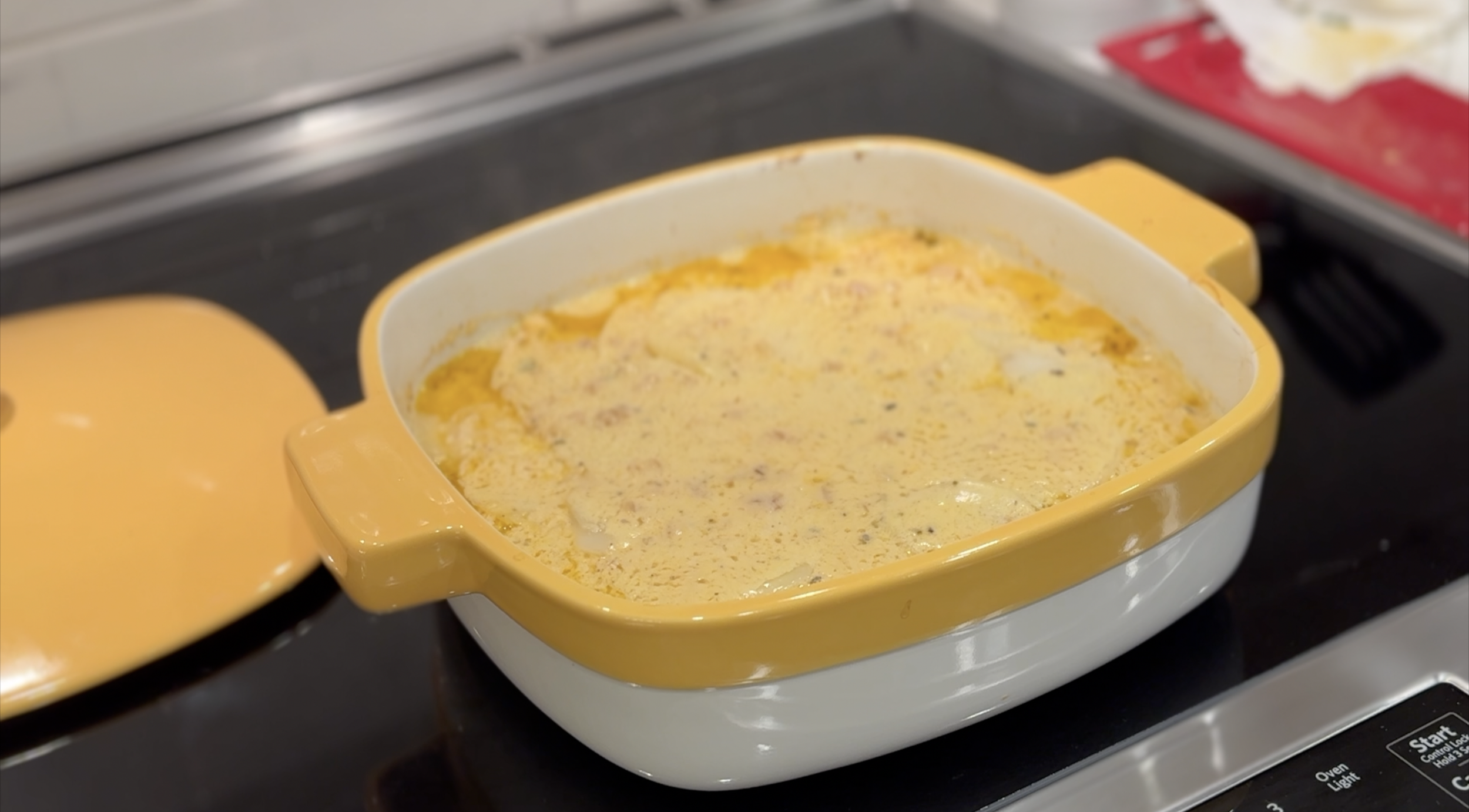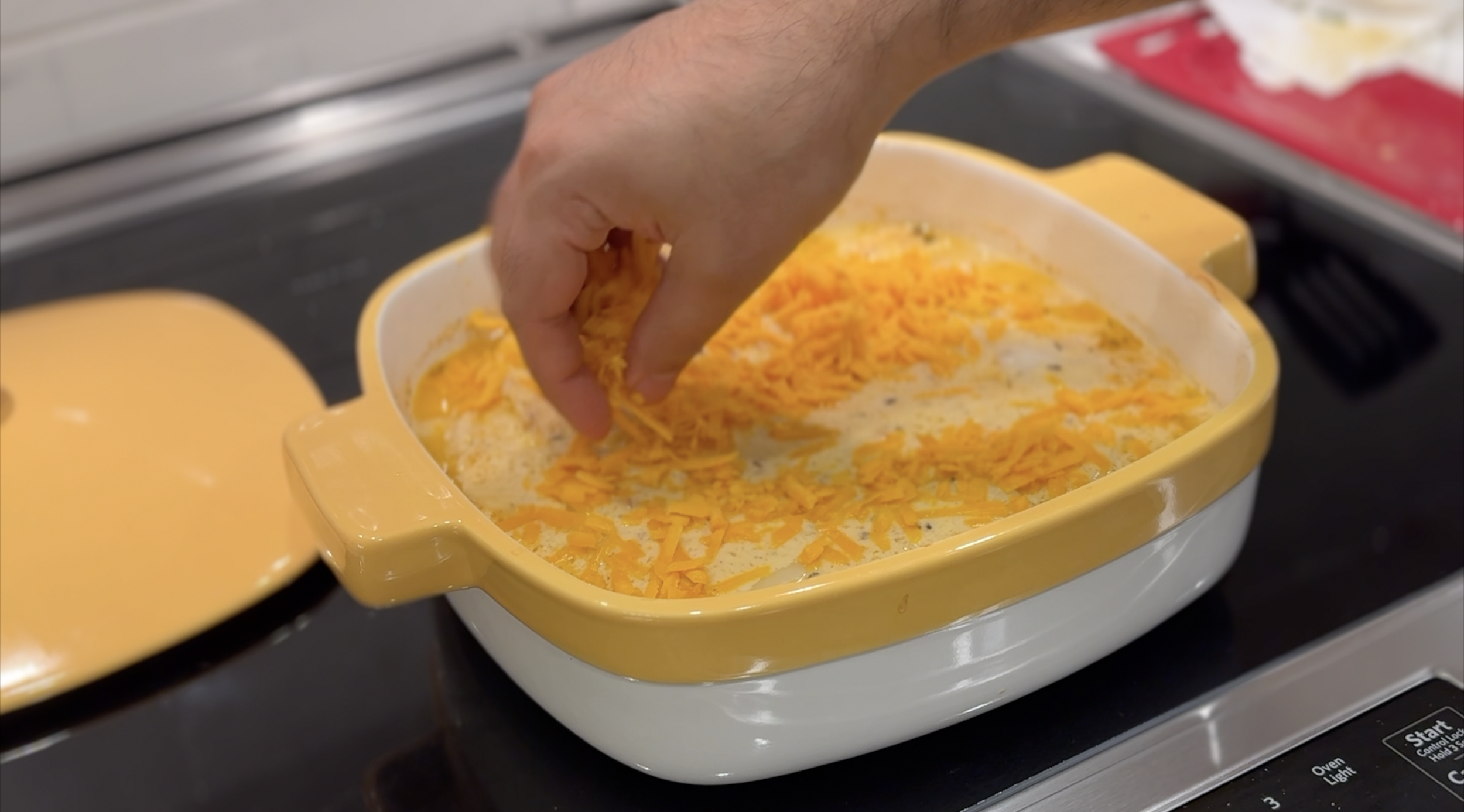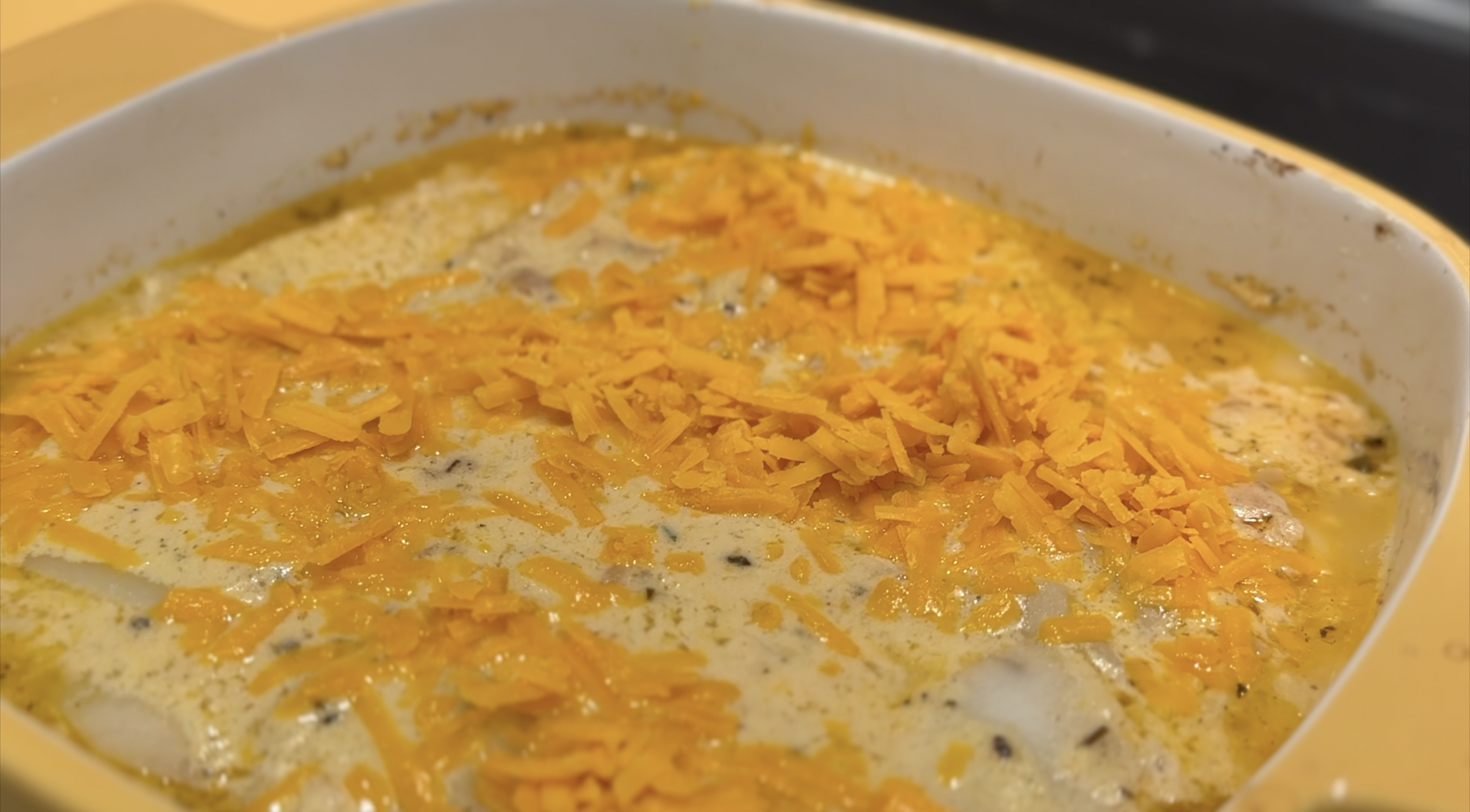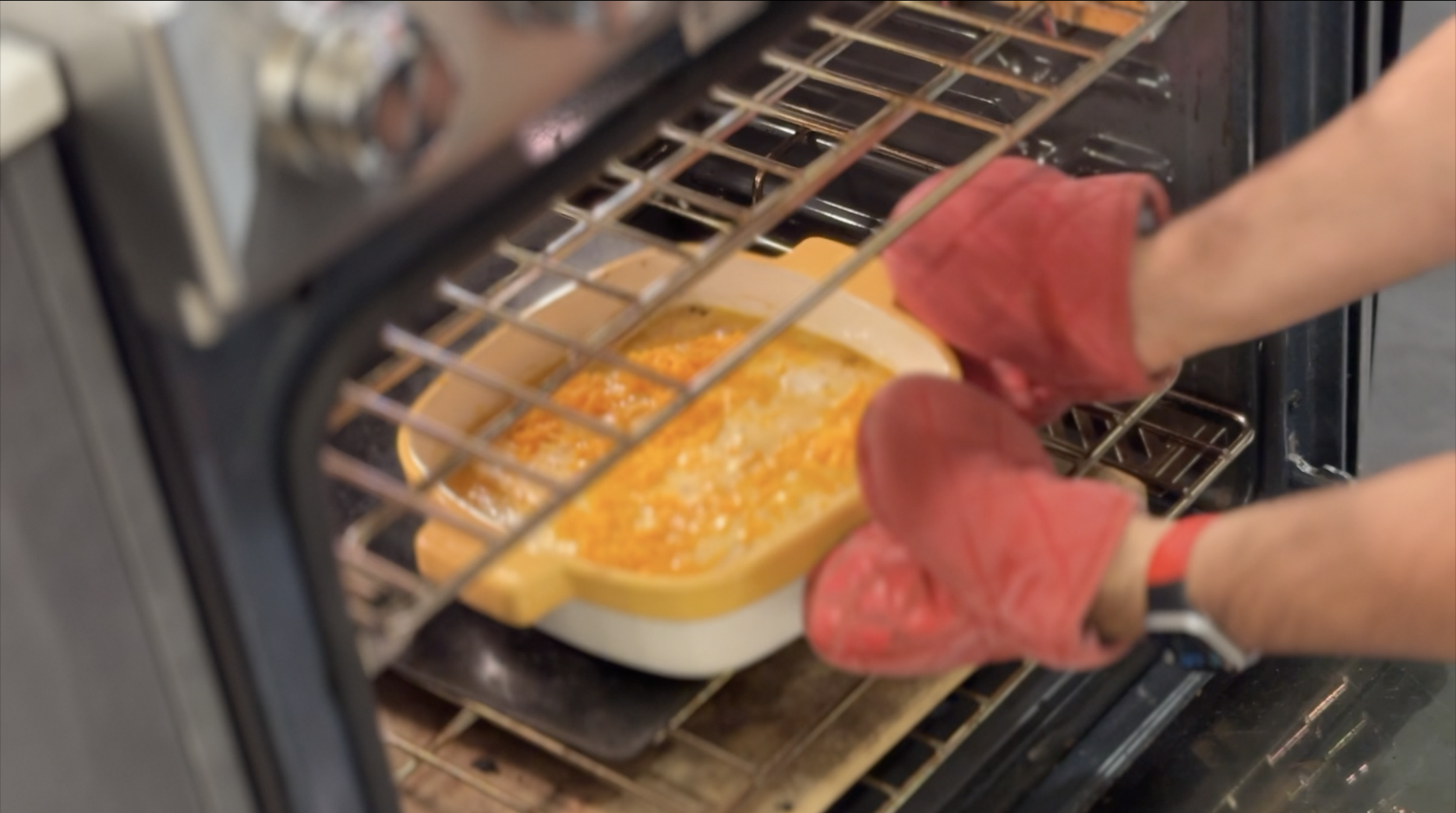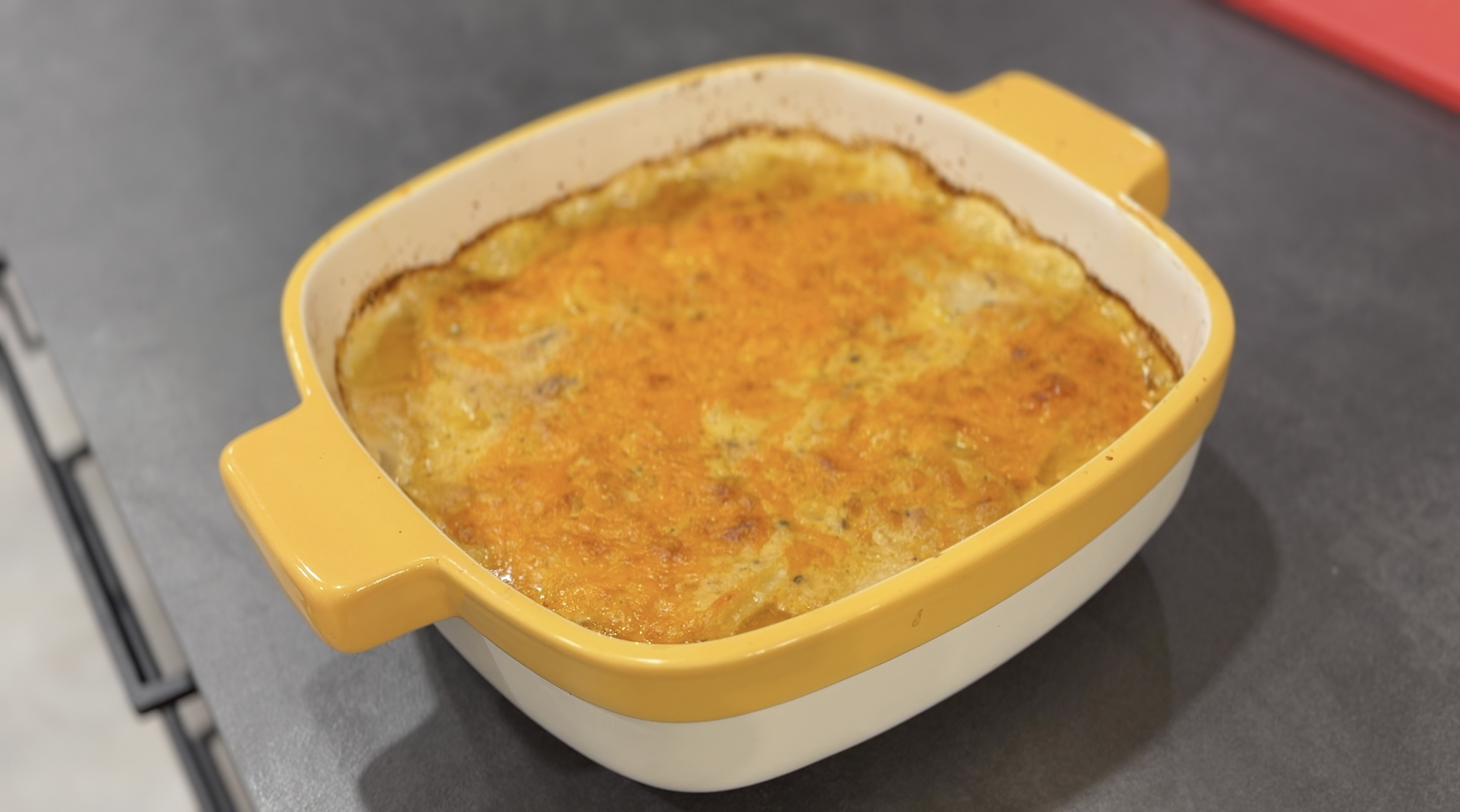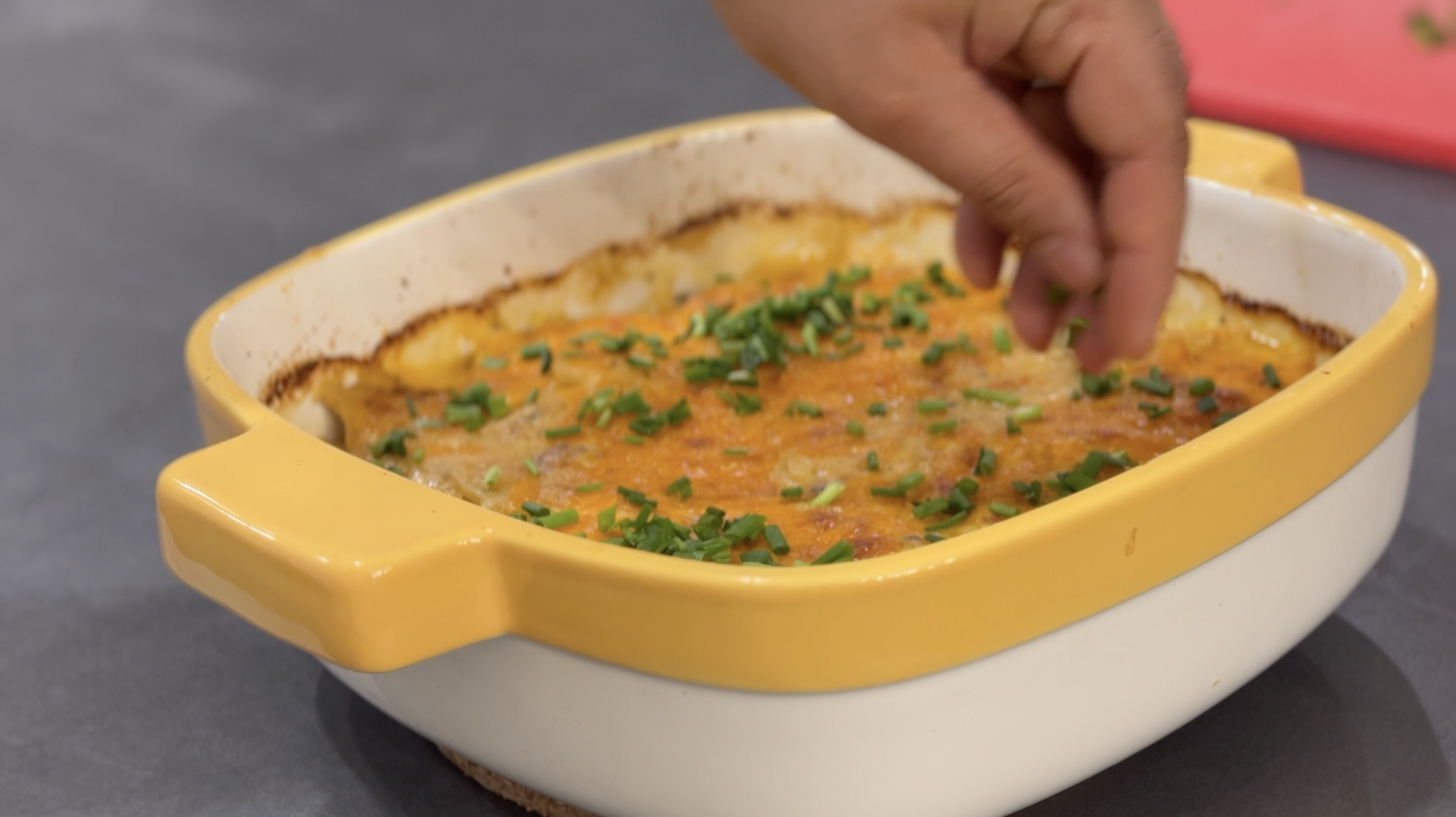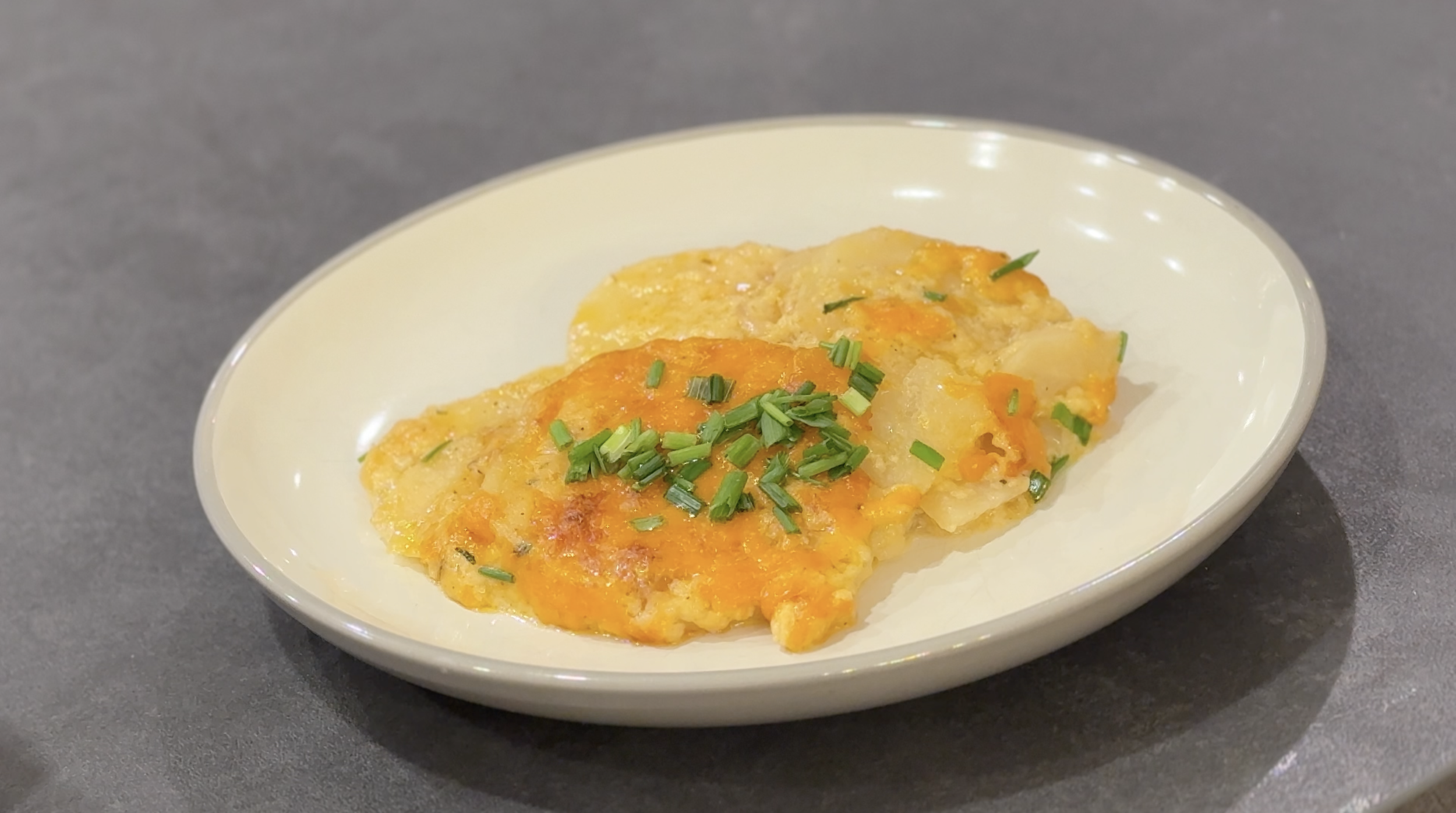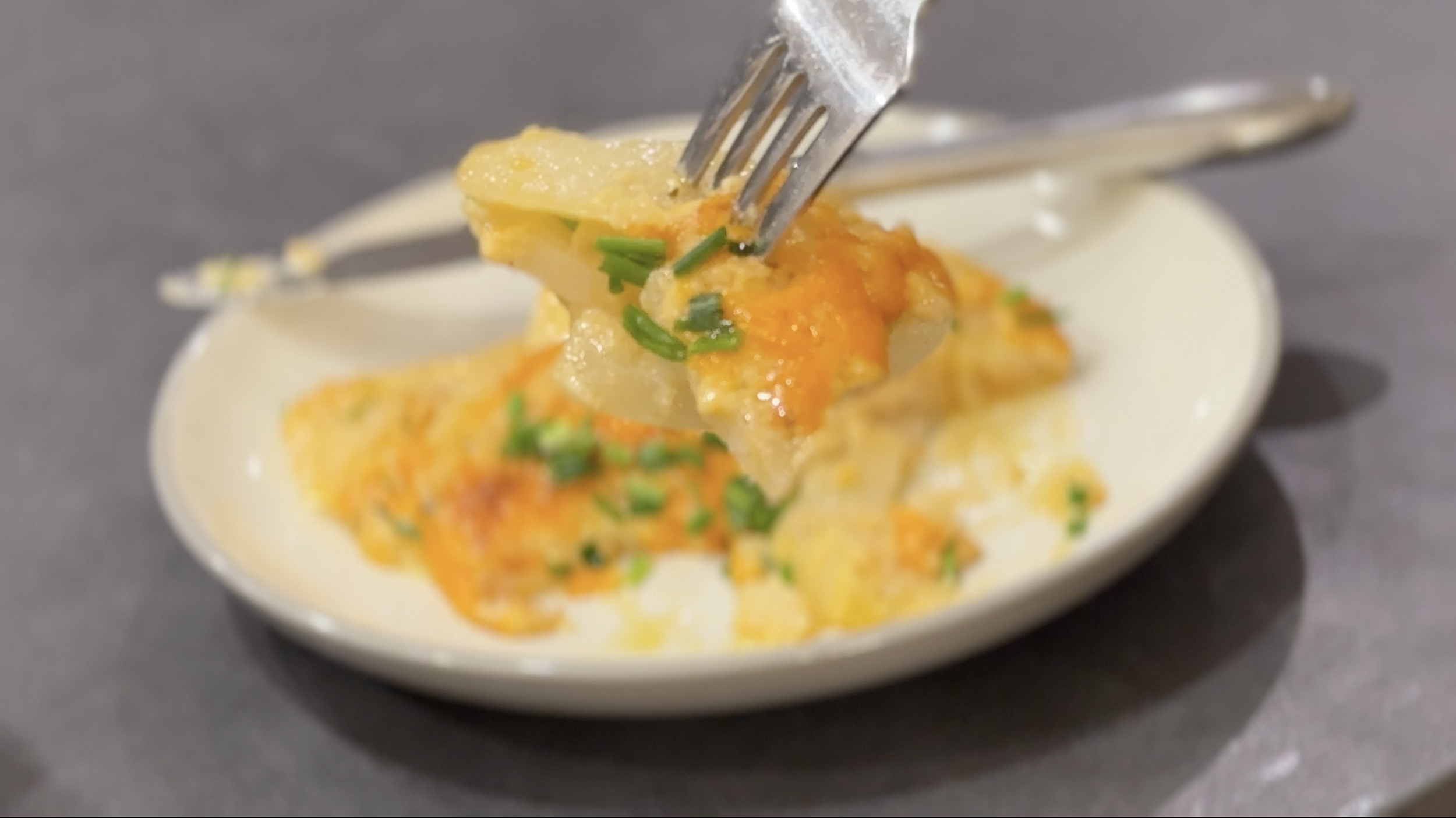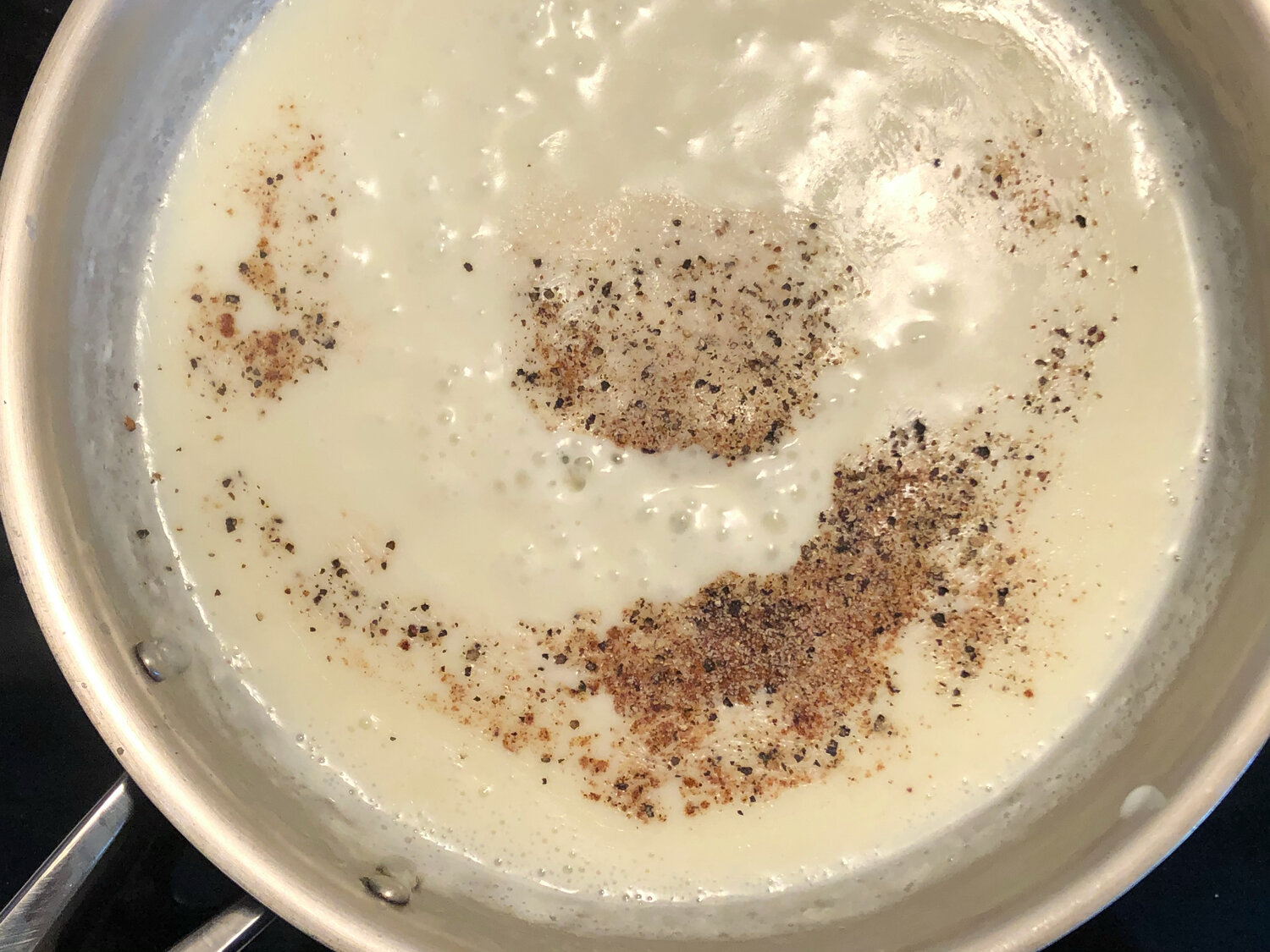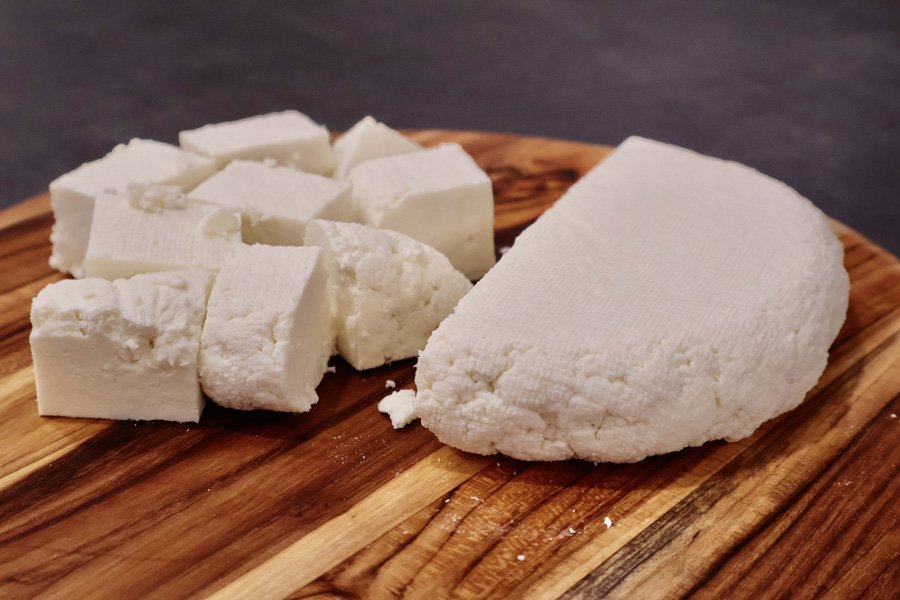Best Cheesy Scalloped Potatoes
This post may contain affiliate links. Read our disclosure policy
Your holiday side dish is ready with the Best Cheesy Scalloped Potatoes recipe! Thinly sliced potatoes layered with a creamy cheese sauce and topped with more golden brown cheese, these Scalloped Potatoes will have everyone coming back for a second helping!
The Best Cheesy Scalloped Potatoes Recipe
Who loves a potato recipe? Now what about potatoes and cheese? You’ve come to the right place for this Cheesy Scalloped Potatoes recipe!
I know I’m posting this on Easter Monday today, which is actually also April Fool’s Day, but this Cheesy Scalloped Potatoes recipe is far from being a joke! I’ve always wanted to make a hearty, cheesy potato casserole, and for Easter time I thought it was the perfect opportunity to share! You can put your heart on a plate for all the potato and cheese lovers for any holiday side dish as part of your Live to Cook one-month challenge with this easy scalloped potatoes recipe! To get started on your cooking journey for free today, then sign up to my free email newsletter, plus all of my latest recipes will be sent straight to your inbox so you’ve always got a delicious dinner idea!
To follow along with this step by step scalloped potatoes recipe, then be sure to watch the video at the bottom of this post! It would mean a lot to me if you would please subscribe to my YouTube channel if you’re not already, and don’t forget to press the bell icon so you’re notified when all of my video recipes are live! Let’s get cooking!
What are Scalloped potatoes?
The exact origins of Scalloped Potatoes are not clear, but there is belief that they originated in England. Many other “scalloped” recipes originate from a dish consisting of baked oysters and breadcrumbs. Regardless of where they come from, Scalloped Potatoes are a side dish where thinly sliced potatoes are placed in a casserole, layered with a creamy white sauce. As I’ll discuss in the next section, typically scalloped potatoes are not prepared with cheese. HOWEVER, I just really love cheese and couldn’t resist adding them! Regardless of whether cheese is added to scalloped potatoes or not, they are an amazing option for a holiday side dish or just to serve for an indulgent potato dish on any occasion!
What is the difference in scalloped Potatoes and au gratin potatoes?
I admit I was super confused on what the difference between Scalloped Potatoes and Potatoes au Gratin is, and a part of me still kind of is! In fact, I think the whole Internet has the lines blurred about the two dishes, because when I Google “Cheesy Scalloped Potatoes,” I get results for Potatoes au Gratin. Conversely, when I Google “Potatoes au Gratin,” results for Cheesy Scalloped Potatoes appear. With lots of digging and reading, here’s what I’ve established:
Both scalloped potatoes and au gratin potatoes are layered with a béchamel sauce or cream sauce.
Potatoes au Gratin have French origins, coming from the Dauphin region of France. They are also referred to as “Gratin dauphinois” in French. “Au gratin” means “with a crust” in French.
Au Gratin potatoes are topped with cheeses (typically cheddar and Gruyère) and breadcrumbs.
Scalloped potatoes are cut slightly thicker than au gratin potatoes.
So, what am I making here? I’ve actually ended up making a cheese sauce, similar to Mac and Cheese, and I’m going to top with some cheese! I actually also cut my potatoes thin like in Potatoes au Gratin because I wanted them thin. While it seems like I’m making a variation of Potatoes au Gratin, the crust from the breadcrumbs and the Gruyère cheese are missing elements. I suppose this is a fusion of both Scalloped Potatoes and Au Gratin Potatoes, but whatever you want to call these, they are so tasty! If you want to see my potatoes au gratin recipe, then feel free to check it out here!
Why You’ll Love Scalloped Potatoes!
Easy side dish: The majority of the work is just in making our cheese sauce, then the oven takes over to bake this potato casserole into a satisfying meal!
Minimal ingredients: There’s not too many ingredients you need for a good Cheesy Scalloped Potatoes! Most of the ingredients required are for the béchamel sauce!
Minimal hands-on work: Once your cheese sauce is prepared, the oven will take over and work its magic, so that you can spend your time cooking more hands-on dishes if this is being made for a holiday meal.
SO TASTY: The main reason you want to have Scalloped Potatoes! I just love the heat, warm and melting cheese, and the tender yet crispy potatoes! It’s so simple but very addictive for sure!
What Kind of Potato Should I use for Scalloped Potatoes?
I’ll be using Russet potatoes for my Scalloped Potatoes recipe. However, you can use Yukon gold potatoes as well. I actually used Yukon gold potatoes for my Potatoes au Gratin recipe and to be honest I couldn’t tell the difference using one potato for another! The key is really to use a starchy potato so that it absorbs the moisture of the sauce while cooking, and so that they hold their shape.
Do You Need to Boil the potatoes before baking the casserole?
No, we are going to add the raw potatoes directly to the casserole. The main answer to needing to boil the potatoes before baking the Scalloped Potatoes casserole is… TIME! If this was a last-minute plan and you’re very hungry, then indeed boiling the potatoes before cooking the potatoes will reduce the baking time in the oven by half! However, since I was not in a rush with making this Scalloped Potatoes casserole, I just added the potatoes raw. Keep in mind that this will take about an hour and 45 minutes to bake, so slashing this time in half can really make the difference! To learn how to boil potatoes in the Instant Pot, check out my recipe here.
What cheese should I use To Make Scalloped potatoes?
Well, as mentioned previously, you Scalloped Potatoes are cheddar cheese and Gruyère cheese. More specifically, the cheddar cheese I used is Red Fox, and I was so hooked on it! It’s perfectly strong making it excellent for scalloped potatoes. Furthermore, despite the price point of Gruyère is the ideal choice because of its flavour and because it’s an excellent cheese for melting. Lots of Potatoes au Gratin recipes top their casseroles with Parmesan as well, but since Gruyère cheese is very strong on its own, I didn’t think that Parmesan cheese was needed this time. Use this time to experiment with similar cheese combinations for your dish.
How do I prevent Scalloped Potatoes from Curdling?
Your béchamel sauce can curdle for multiple reasons, but the main root of the problem is because the proteins in the but in essence when the proteins in the milk denature, it causes the split. This can occur for several reasons, some of them being cooking the casserole at high temperatures and for cooking for extended durations.
Make sure to cook out the roux for the béchamel really well before adding the milk and then mixing the ingredients well together.
Sometimes older milk can curdle much easier than fresh milk, so try and use the freshest sourced milk if possible.
Ensure that you keep the oven’s temperature between 350 F to 375 F for best results when baking.
Tools needed to make scalloped potatoes
Peeler: To peel your potatoes before cutting.
Chef’s knife: I’m cutting my potatoes with a sharp knife since I don’t have a mandolin slicer.
Microplane: Used to grate whole nutmeg into your béchamel sauce.
Measuring spoons: To measure the spices for the béchamel sauce.
Measuring cup: Useful for measuring your cheese and milk.
Mixing bowl: To keep the sliced potatoes while you work on the béchamel sauce.
Ramekins: To keep you organized for prep purposes.
Garlic press: To mince the garlic into the béchamel sauce.
Cheese grater: To grate the cheese.
Saucepan: Where you’ll make the béchamel sauce.
Pepper mill: In my opinion, freshly ground black pepper is the most flavourful, so a pepper mill has really been a game changer for me!
Casserole: To bake the scalloped potatoes. My casserole dish is 8 inches by 8 inches.
Spatula: Used to stir the ingredients for the béchamel sauce.
Basting brush: To brush on olive oil or butter onto the casserole so that your potatoes don’t get stuck and potentially burn at the bottom!
Ingredients To Make the best cheesy scalloped potatoes
Scroll to the bottom of this post or press the “Jump to Recipe” button for the FULL PRINTABLE RECIPE CARD, which will give you the full list of ingredients and their quantities, plus you can save the recipe for later. You can also use the recipe card to scale the recipe card based on the size of your casserole and how many portions of Cheesy Scalloped Potatoes you want to make so that everyone gets a full plate!
Potatoes: I’ve used Russet potatoes for my Scalloped Potatoes, but you can also use Yukon gold potatoes. As I mention in my free motivational guide to explore your potential in the kitchen, Make Cooking Fun!, if you’ve got some older Yukon gold potatoes on hand that are waiting to be used up, then be sure to use those before running to the grocery store and getting some new potatoes! When there is a feasible substitute that needs to be used up, then save yourself the time and money and make sure your ingredients don’t go to waste!
Herbs: I used some fresh thyme to flavour the béchamel sauce.
Milk: I used whole milk here, and this will give you the best results. You add the milk to the flour and butter, which is the roux. Cold milk is optimal to prevent lumps in your sauce!
Butter: I always recommend that you use unsalted butter so that you have more control over the amount of salt in the dish overall.
All-purpose flour: Mixed with butter to prepare the roux.
Onions: Sauté the onions with the flour and butter to add some sweetness to the béchamel sauce.
Garlic cloves: Mince the garlic cloves and sauté with the butter and onions for the béchamel sauce.
Cheese: Some sharp cheddar cheese that will be added to the white sauce and then more on top when it’s time to bake!
Seasonings: I will be grating whole nutmeg and adding dried bay leaves and dried sage leaves, in addition to a dash of ground cayenne pepper to add colour and a slight amount of heat.
How to Make The Best Cheesy Scalloped Potatoes
Preheat the oven to 350F. Peel the potatoes and slice to 1/8th inch thick slices.
Add the potatoes to a large bowl and set aside for now.
Heat a pan on medium heat and add butter. Once the butter melts, add in the onions, minced garlic and sauté for 5-6 minutes and then add cayenne pepper Mix in the flour and whisk for 2-3 minutes until the rawness of the flour is cooked out. The roux will begin to smell nutty, which is a good indicator that it is cooked.
Pour in your milk, little bit at a time while whisking to work out any lumps. Once all your milk is mixed in, wait until your sauce starts to come up to a simmer.
As soon as the sauce comes to a simmer, it will begin to thicken. Season with salt, pepper and ground nutmeg and then add the thyme, bay leaf and sage. Once the béchamel is thick enough to evenly coat the back of a spoon remove the saucepan from the heat add half the shredded cheese.
Brush butter or olive oil on the bottom of the casserole. Arrange the potatoes in a single layer and then add some of the béchamel sauce to cover the potatoes. Repeat the same until you have added all of the potatoes and topped the final layer of béchamel.
Cover tightly with aluminum foil or add the lid to your casserole, and bake the scalloped potatoes for 50-60 minutes or until the potatoes are fork tender. Remove the casserole from the oven, top with the remaining cheddar cheese and bake for 20-30 more minutes or until the cheese has browned.
Let the casserole rest for at least 15 minutes before serving.
Enjoy!
TIPS to make the most amazing scalloped potatoes
To ensure that the potatoes cook at the same rate, be sure to slice the potatoes evenly.
Caramelize onions for some extra sweetness to your casserole.
Always use cheese blocks and shred it fresh for the tastiest results!
You know that the roux for the béchamel sauce is ready when it is slightly dark and it smells nutty.
Make sure to discard the thyme and bay leaf from the béchamel sauce before baking the casserole. These were only used to scent the sauce.
Cover the casserole tightly in order to allow the steam cook the potatoes low and slow.
In case the sauce splits or curdles, add some heavy cream, lightly mix together and continue baking.
How to Serve Scalloped Potatoes
Mains for a holiday meal: Beef Bourguignon, No-Fail Roast Chicken, Lemon and Thyme Chicken Schnitzel, Shrimp Scampi, or Pan-Seared Blackened Salmon.
Other side dishes: Chicken Tenders, Arugula Salad with Feta, Dinner Rolls, Baked Spinach Dip, Indian Chicken Cutlets.
Can I Make scalloped Potatoes ahead of time?
Of course you can! Actually, Scalloped Potatoes are a go-to choice for a holiday meal because they keep well in the fridge and they can easily be prepared in advance!
How to Store Scalloped potatoes
If there’s space in the fridge, you can store your Scalloped Potatoes directly in the fridge in the casserole you baked it in! Additionally, if your casserole has a lid, feel free to cover it with the lid, but if it does not, then cover the top with plastic wrap. Because of the large amount of dairy used to make Scalloped Potatoes, I wouldn’t keep them in the fridge for longer than 3 to 4 days. Furthermore, I do not recommend that you freeze your Scalloped Potatoes because potatoes do not defrost well. In my opinion, they become soggy when you defrost them, and with the condensation from the cheese, you’ll just have a lumpy mess, plus you’ll miss out on the crispiness of Scalloped Potatoes!
How to Reheat Scalloped potatoes
While you technically could reheat Scalloped Potatoes in the microwave, this isn’t my recommended method because the potatoes will lose their shape, meaning you’ll lose the nice layers! While you’ll need to be patient, it’s well worth reheating your Scalloped Potatoes in the oven. Simply preheat the oven to 350F and reheat the potatoes in the casserole for about 25 to 30 minutes, depending on how large of a portion you’ll be reheating.
More extremely tasty potato recipes!
Watch How to Make the besty cheesy scalloped potatoes Here:
Let me know what you think of this recipe in the comments! If you’ve tried this recipe, be sure to post it on social media and tag it with #cookingwithanadi and mention me @cooking.with.anadi. Thank you!

The Best Cheesy Scalloped Potatoes
Your holiday side dish is ready with the Best Cheesy Scalloped Potatoes recipe! Thinly sliced potatoes layered with a creamy cheese sauce and topped with more golden brown cheese, these Scalloped Potatoes will have everyone coming back for a second helping!
Ingredients
- 2 Russet potatoes, peeled and sliced 1/8 inch thick
- 1 1/2 Tbsp butter
- 1/2 medium onion, finely chopped
- 2-3 garlic cloves, minced
- 1/2 tsp cayenne pepper
- 1 1/2 Tbsp all purpose flour
- 1 1/2 Cup cold milk
- 1/4 tsp ground nutmeg
- 1 stem fresh thyme
- 1 bay leaf
- 1/2 tsp dried sage
- salt and pepper to taste
- 1 Cup cheddar
Instructions
- Preheat the oven to 350F. Peel the potatoes and slice to 1/8th inch thick slices. Add the potatoes to a large bowl and set aside for now.
- Heat a pan on medium heat and add butter. Once the butter melts, add in the onions, minced garlic and sauté for 5-6 minutes and then add cayenne pepper Mix in the flour and whisk for 2-3 minutes until the rawness of the flour is cooked out. The roux will begin to smell nutty, which is a good indicator that it is cooked.
- Pour in your milk, little bit at a time while whisking to work out any lumps. Once all your milk is mixed in, wait until your sauce starts to come up to a simmer.
- As soon as the sauce comes to a simmer, it will begin to thicken. Season with salt, pepper and ground nutmeg and then add the thyme, bay leaf and sage. Once the béchamel is thick enough to evenly coat the back of a spoon remove the saucepan from the heat add half the shredded cheese.
- Brush butter or olive oil on the bottom of the casserole. Arrange the potatoes in a single layer and then add some of the béchamel sauce to cover the potatoes. Repeat the same until you have added all of the potatoes and topped the final layer of béchamel.
- Cover tightly with aluminum foil or add the lid to your casserole, and bake the scalloped potatoes for 50-60 minutes or until the potatoes are fork tender. Remove the casserole from the oven, top with the remaining cheddar cheese and bake for 20-30 more minutes or until the cheese has browned.
- Let the casserole rest for at least 15 minutes before serving.
Nutrition Facts
Calories
255.53Fat (grams)
12.34 gSat. Fat (grams)
7.23 gCarbs (grams)
28.23 gFiber (grams)
1.95 gNet carbs
26.27 gSugar (grams)
5.81 gProtein (grams)
9.24 gSodium (milligrams)
216.21 mgCholesterol (grams)
36.55 mgNutrition info is an estimate.
Follow me
Meet Anadi
Welcome to Cooking With Anadi. This platform is all about making cooking exciting and finding new ways to bring classic flavours and recipes at your service. Join me in my personal journey in the world of cooking. Hope you have a great ride!








